#also the threes' appearances are relevant to the appearances of the deities.
Explore tagged Tumblr posts
Text
Religion in Swiftpaw's wish
Inspired by @theoriginalkittypet's lion god au
There were once three gods, Lion [Andromedous], Tigress [Neutraliss], and Leopard [Saggitaro]. Bored of their loneliness in the darkness of the void, they created four domains: The domain of Good, the domain of Mediocrity, the domain of Bad, and the domain of the Living.
Lion took the domain of Good as his main haven, Tigress the domain of Mediocrity, and Leopard the domain of Bad. They all agreed to rule over the fourth domain equally, as the living's recollection of them was what would keep them alive from now on. Things went well for a while; They created twolegs and cats first, and then dogs. After, came the animals of prey, and later the animals intended to keep Cat populations from soaring.
As many many centuries passed, cats began to idolize Lion, fear Leopard, and ignore Tigress. This lead to animosity between the three friends, as Lion's ego grew, Tigress's confidence shrank, and Leopard's concern began to plague their interactions with their friends. Leopard did their best to support Tigress, but she was too downtrodden by the mortal's lackluster opinions of her. Meanwhile, they tried to reason with Lion, but he became increasingly more frustrated with the mortals, as they each had their individual ways of respecting and worshiping him, many of which did not line up with his word.
Many years of this all went by, and eventually, Leopard was sent a cowering, terrified molly - Frecklewish - from Lion's domain. Angry, Leopard started reforming the domain of Bad, shaping it to have levels catered to your level of bad. Many cats who weren't entirely good, but were not one to acknowledge Tigress in life, wound up in their domain, so they made it so that those cats had a safe place to live in their domain. They took a liking to Frecklewish in particular, and decided to make the poor terrified molly their messenger (much to the much worse mapleshade's anger).
Impressed by this new idea, Tigress began looking for her own messenger, as Leopard's relationship with the other two began clearing up due to their use of their beloved messenger. Tigress chose a member of the Sisters who wound up in the domain of Mediocrity, despite having been decently good in life, and her new messenger began teaching her to be confident again. Unfortunately, around this time, Tigress found signs and prophetic warnings that she was fading. It would take a millennia or two, but because of Lion's polarized views, she was being forgotten, and slowly dying. So, she conceived a plan with Frecklewish and Leopard: Convince Lion to send an aspect of each deity to the domain of Living in order to renew belief in their true selves, rather than the selves that Lion and his followers had been spreading.
Lion remained adamant for a long time that he would not do this. He, in all his darkened glory, had grown embellished in his beliefs and saw himself as the one true god over his old friends. It wasn't until the forest clans borne a cat with a striking resemblance to a lion that he began to consider their proposition. This cat, Lionkit (later Lionheart), became his favorite, a living reminder of his old glory. He strove to become like this cat as the cat grew and became an intelligent and wise adult, and was proud to witness him become a deputy in his clan. Unfortunately, he was killed defending his clan in a traitorous rally, and upon joining the domain of Good, Lionheart was given a choice: Become Lion's messenger, or remain on the lower levels of Good, bordering Mediocrity for the rest of his afterlife.
Lionheart, shocked but happy to receive the blessing of being Lion's messenger, accepted the less-than-optimal ultimatum, and joined Lion. Slowly but surely, he worked with Frecklewish and Starlight (Tigress's messenger) to get Lion to agree, and by the time the legendary Firestar had kits with Sandstorm, they convinced him to send a prophecy - The prophecy of the Three - to the domain of the living. The three - Hollyleaf (Tigress), Lionblaze (Lion), and Jayfeather (Leopard) - would be their aspects in the domain of the Living until death, in which they would become advisors to the gods.
It was the three's job to restore faith and content in the gods, and they would have to start by fixing the structure of the clans. The plan was for the main one of the trio to be Holly(Snow)leaf - An albino tom (later molly) with spiky fur and red eyes - to be Tigress's mortal self, and to spread the word that things must be changed if everyone is to survive in sanctity and peace. (Hollow)Lionblaze, a near-melonistic molly (later tom) with red undertones, would show that Lion is not the perfect deity everyone assumed him to be. And finally, Jay(Amber)feather, a golden tabby tom (later molly) with unusual spots, would be there to represent the anger Leopard felt for the mistreatment of cats by Lion and Tigress.
Upon their maturing, and the discovery of their heritage, things went horribly against the plan. Hollyleaf killed Ashfur, and then revealed Leafpool's secret to the whole of the clans. (S)He was unable to be contacted anymore, as the last cat (s)he was seen with was Sol, and Tigress began to grow ill. She soon resurfaced, now going by Snowleaf and using she/her pronouns, and everyone was so relieved that they sent down their messengers to follow her for a little bit. During this time, Snowleaf and Ivypaw became friends, and they began talking about how to change the code and the clans...
... And so, the deities recalled their beloved messengers, and the world breathed a sigh of relief. The prophecy would be fulfilled.
#swiftpaw's wish#warrior cats#swiftstar au#hollyleaf#warriors god concept#as an aside: their real names are mentioned but not used because they cannot properly translate these names into catspeak.#also the threes' appearances are relevant to the appearances of the deities.#yes dove is scrapped as a member of the three for a reason.
5 notes
·
View notes
Text
Renna's identity and more Caria stuff
I think we have finally come to a satisfying conclusion on the identity of the Snowy Crone, aka Renna.
This came from a conversation with Qamarmoon (not on Tumblr, but check out the Blusky account [x]), who pointed out an interesting bit about her and the two sisters Rennala and Rellana. Together they appear to follow the triple deity format: Renna being the Crone, Renalla being the Mother, and Rellana being the Maiden. It's also worth pointing out that each facet of this Triple Goddess is also connected to moon phases.
It was also correctly pointed out that Snowy Crone must have known the Dark Moon if she was capable of teaching Ranni about it.

But the only ones we have seen capable of such contact with the moons appear to be part of Carian royalty.
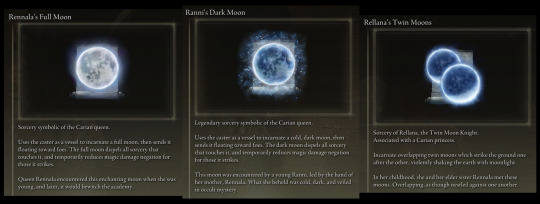
The one exception may be the Nox... however, they seemed to have owned the Moonlight Altar in the past, as the Cathedral of Manus Celes shares architecture with the Church of Vows, an old Liurnian ruin intimately connected to the Nox and their rituals.


(My friend @katyspersonal also believes the Nox's Black Moon might have simply been an imitation they created, as it seems to have worked differently than the other moons we know of. For example, it wasn't just one person envisioning it, but multiple. It was also physically present underground and was even broken apart by Astel, while these other moons seem much more distant. It's not necessary to believe this in order for the whole theory I'm proposing to work, but if it's true it would certainly strengthen it lol)
In any case, Qamarmoon also posited that the three sisters might have indeed referred to Renna, Rennala and Rellana, and that Seluvis' Rise wasn't the only one that got its name changed, but Ranni's too, leaving Renna's as the only untouched one. Interestingly enough, it's also where you find the Snow Witch set.
The whole convo made me suddenly remember something I had always taken for granted... the Ice Crest Shield.
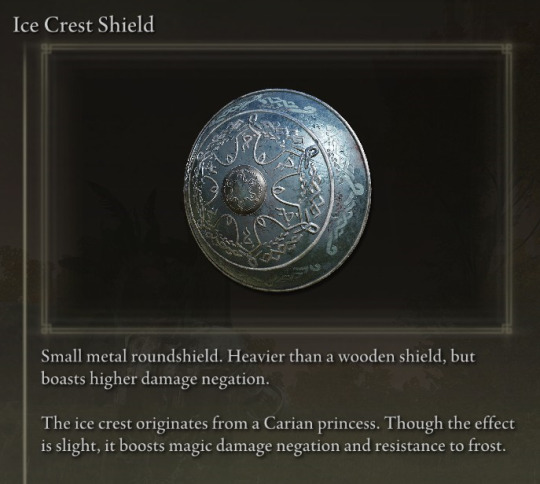
This small shield, found in Caria Manor, has a snowflake design that was said to be the crest of a Carian princess. Now, I had always assumed this was referring to Ranni, but I realized something. If it were, it wouldn't have been vague about it. When symbols and insignias are relevant to a specific Demigod or important person they are never spoken about like that... and besides, the crest should be found somewhere else related to Ranni herself if it was hers.
But it's not, and what really seals the deal for me is that Ranni's connection to the cold wasn't something well-known, as it came from her secret mentor, the Snowy Crone.

Ranni, for all intents and purposes, was a moon witch like her mother, earning the title of Lunar Princess.
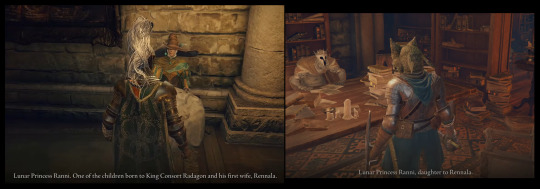

Even Blaidd's blade was imbued with frost only when he vowed to never leave Ranni's side no matter what, walking that dark path with her. The cold seems intimately tied to her secret grim fate.

Even more damning, is that the Glintstone Sorcerers of the Lazuli Conspectus, a Carian-affiliated branch of the Academy of Raya Lucaria, wield the Ice Crest Shield.
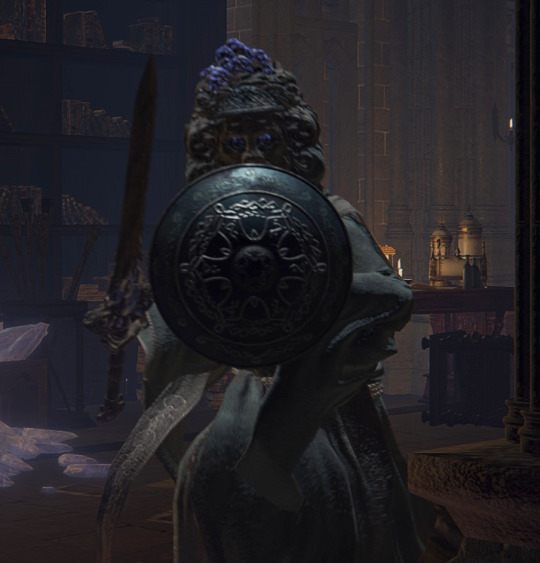
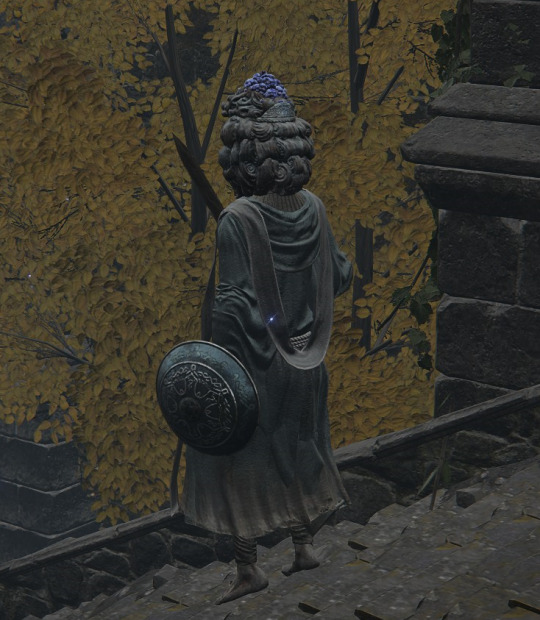
However, the Conspectus more than likely predates Ranni by a long margin and seems to have no connection to her overall. Furthermore, the colors of their robes, while likened to the hues of a Full Moon, do contain white accents reminiscent of the Snow Witch set, which was Renna's before it was Ranni's.
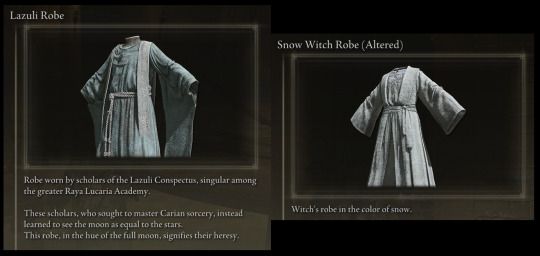
So then, could it be that Renna is the Carian princess mentioned on that very shield? Maybe even Rennala and Rellana'a older sister! There seems to be quite a bit of evidence for it!
But, I understand if you are skeptical. After all, why wouldn't she be the Queen of Caria if she was the eldest daughter, or even mentioned at all? Better yet, how would it work if Caria as royalty was established by Rennala herself as stated by her Remembrance?
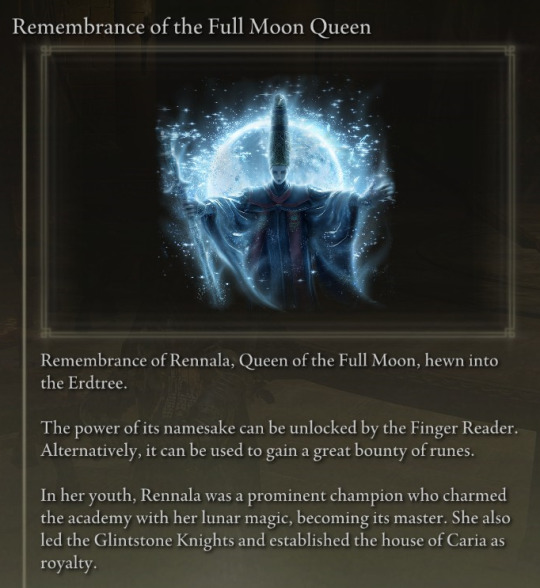
Let's start with the latter. I do not believe that statement is proof enough to come to such a conclusion. Don't get me wrong, it would be, if it weren't for the fact it's the only instance of this, and it's contradicted by so many other descriptions.
And you may say it's not true. The Stargazer Heirloom also implies the same. After all, it speaks of a young astrologer finding the Full Moon and becoming queen.
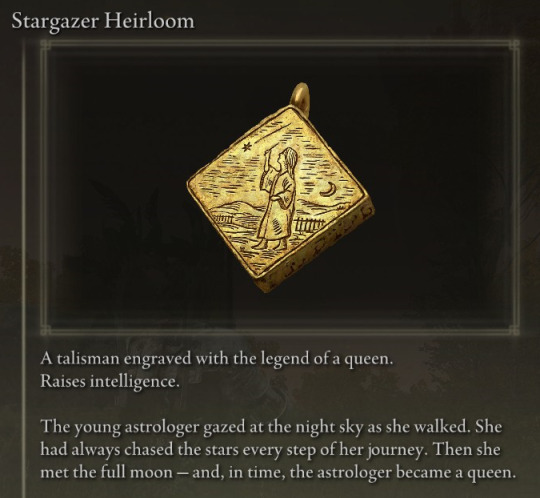
It does sound a lot like Rennala, right? But two small bits prevent it from being the case. The first one is the fact that it's engraved with a "legend". The only other heirloom with this description is that of the Two Fingers. Meanwhile, the two heirlooms depicting Radahn and Malenia, prominent figures of the current Lands Between, are said to be depicting "a scene from a heroic tale". Legend implies a certain degree of antiquity, which Rennala does not seem to possess.
The other detail, which is even more weighty, is that she is referred to as an astrologer. Astrologers were ancient people situated on the Mountaintops of the Giants and were once their neighbors. So close was their bond that they created a sword to honor it.

Some of the Carians, like Rellana, even believed that Fire and Moon should always be together, which is part of the reason she followed Messmer during his Crusade.
So the astrologers are the ancestors of the Carians... but they are not the only ones who descend from them. All Glintstone Sorcerers are descendants, in fact!

After all, it was an ancient astrologer who once envisioned the Founding Rain of Stars, basis of all Glintstone Sorceries and the foundation of the Academy of Raya Lucaria.
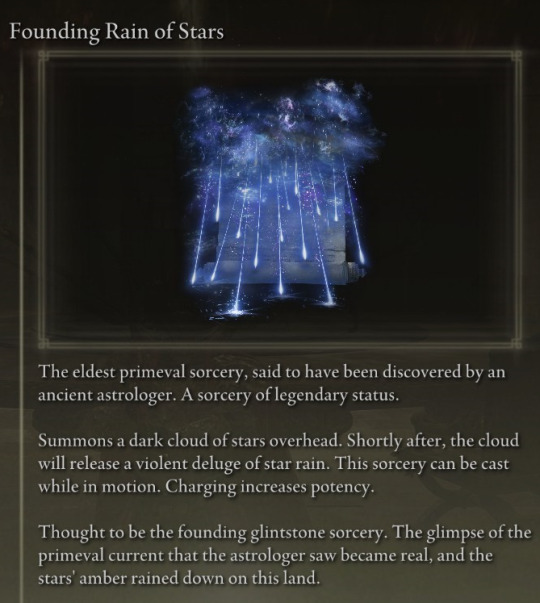
If Rennala had been that very astrologer girl in the legend, then she not only would have been incredibly ancient by now, but it would also mean she enchanted the academy immediately after its founding, since they'd be part of the same time period. This would leave them no room to develop the opposing beliefs that created the current friction between the two factions, which doesn't seem to be the implication.
The woman in the heirloom is most likely just Rennala's ancestor, who envisioned the Full Moon and changed the trajectory of her branch of astrologers forever.
This isn't the only thing against the idea Rennala is the sole founder of the house of Caria as well as its one queen! Counter-evidence comes in the form of several descriptions mentioning long-standing traditions involving princesses and matrimony... which wouldn't make sense if Rennala had been on the throne child-free with only her little sister for god knows how long...

In fact, another point towards the idea that Rennala was a princess herself once is her use of a particular ability, said to be employed by Carian princesses specifically. And she's the only Carian character to ever use this technique...
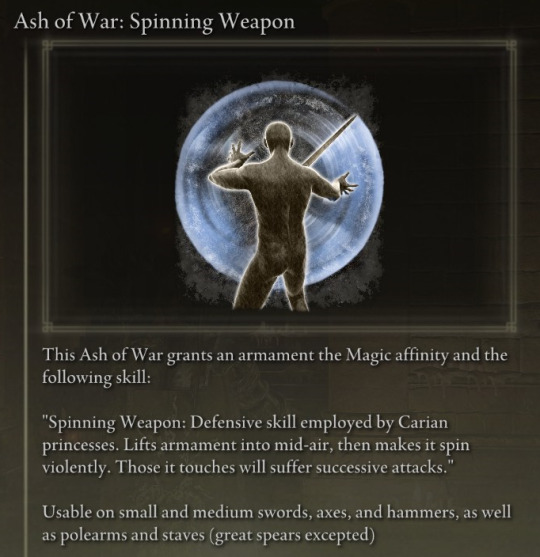

My very last bit of evidence is the fact she is also known as the "last Queen of Caria". A title given to her by her own daughter Ranni.

Now, there would be no point in making such a specification if she had been the ONLY queen of Caria up to that point. What makes more sense, coupled with everything else we have already talked about, is that she is the last queen in a long line of queens...
Simply put, I don't believe the Remembrance implies that she is the sole founder of the House of Caria. It is already considered a "house" after all, so it had the status of nobility at least, and noble houses, as you may know, aren't always in charge as rulers. Several houses contend for sovereignty, and it's often a cyclical thing.
Perhaps Rennala was simply the one to bring Caria back to its former heights by discovering the very same Full Moon that once uplifted her people long ago... this also means that multiple people can witness the same moon, which fits nicely with both Renna and Ranni envisioning the same celestial object.
This leads us back to the question of "what happened to Renna then, and how can she be the older sister if she didn't inherit the throne and Rennala did?".
I think the answer lies in the moon she had discovered. @katyspersonal proposed an idea some time ago, that the moons discovered by the Carian royals sort of foreshadow their eventual fate (It's mentioned in this post here [x] though it's mostly about a hypothetical Moon Goddess as a counterpart to the Fell God). It's something Qamarmoon also concluded independently, so I wouldn't say it's a nonsensical conclusion to draw.
The gist of it is that Rennala's Full Moon foreshadowed her union with the Erdtree, as the full moon is the result of its surface being bathed in the light of the sun, Rellana's Twin Moon foreshadowed her fate intertwining with Messmer, their two powers standing together, and Ranni's Dark Moon foreshadowed the lonesome occult path she'd have to walk to "obscure" the light of Grace.
The theme of celestial objects controlling the fate of all individuals is something quite prominent in the setting, so I'm pretty sold on this concept personally!
So yes, I believe Renna simply walked an occult path that led her to obscurity, maybe even of her own volition. To renounce her birthright in pursuit of something different... it's exactly what Rellana had done in an attempt to stand by Messmer's side.

It's also quite common for prominent figures to completely vanish in the Lands Between, as odd as it is to say. For example, we know that all the Demigod children of Marika who did not survive the Night of the Black Knives (minus Godwyn of course) have all but disappeared from history. We only know they existed, not what they did or accomplished. It's bizarre, to say the least...
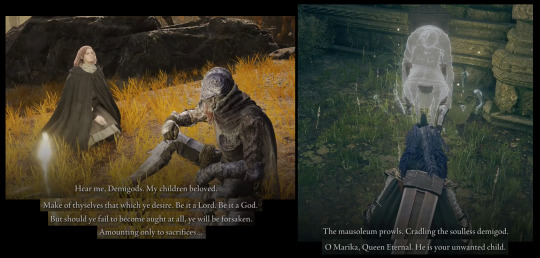
Not to mention the entirety of the Land of Shadow, obscured and forgotten as an endless war is waged. Rellana too has had any mention of her having existed seemingly scrubbed from history, at least in the Lands Between.
Furthermore, it's exactly what Ranni did as well, erasing all of her steps and seemingly vanishing without a trace.
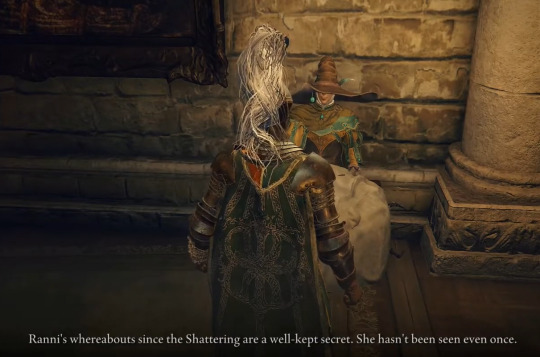
But what became of Renna then? Perhaps her insistence that Ranni fears the Dark Moon is from experience, and she doesn't want her to commit the same mistakes...
The two most prominent traits of the Snowy Crone are the blue skin and the four arms, features that remind me of the accursed followers of the Royal Revenants, often known as Wraith Callers due to the bells they use to attract vengeful spirits.
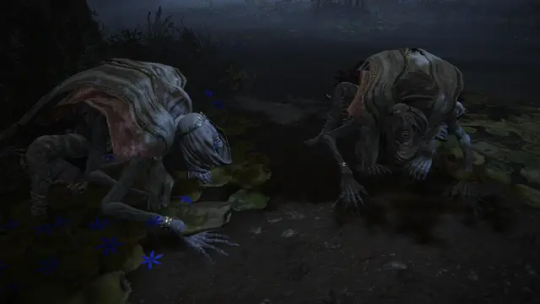

Interestingly enough, Liurnia has the biggest concentration of these guys out of all locations in the game. Most prominent for this theory is their large numbers in the Moonlight Altar, a place that's very relevant to all Carian royalty.
These beings are said to be all cursed, explaining their spectral, twisted forms. Now, I don't think Renna became like the ones we find in-game. They don't seem to hold any connection to the moon and ice, but rather to curses and wraiths. However, she might have died and been cursed in a similar manner, twisting her into a form closer to that Ranni's body is based on.
It's also worth pointing out that Ranni is the one who hands the Spirit Calling Bell to us, which is basically the good version of the Wraith Calling Bell that the Revenant Followers use. However, it's unclear why she wants to give it to Torrent's new master, so it might have not belonged to the Snowy Crone originally.
-
So in conclusion... the idea that the Snowy Crone was actually a princess of Caria named Renna, sister of Rennala and Rellana makes a surprising amount of sense! It neatly explains the crone's knowledge of the Dark Moon, the existence of the Three Sisters in general, the identity of the princess the ice crest was a symbol of, the suspiciously familiar name of Renna feeling just like she is part of the Carian family... it just works so well I think!
Finally. It's a conclusion I am satisfied with... Elden Ring feels very complex regarding most of the unseen people in the cast. Gently waiting for the day we can finally understand the Gloam-Eyed Queen too in such a satisfying manner. Then I will know peace lmao.
---UPDATE---
Ok, so this line from Iji was brought to my attention in the comments, mentioning Ranni as the "first heir in the Carian royal line".
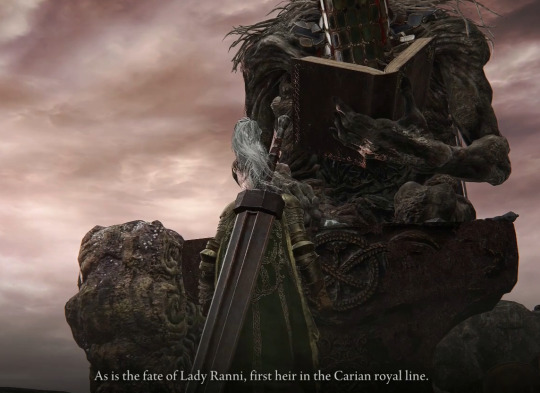
This almost makes it sound like there weren't any heirs before her, which would invalidate literally everything I've said so far about Rennala not being the first Carian queen.
So I decided to check the Japanese script [x], and this line is as follows there: "カーリア王家正統の王女たるラニ様の、運命もまた同じはずです". The part we are gonna focus on is the one I've highlighted.
That doesn't translate to "the first heir in the Carian royal line" but rather "the legitimate princess (正統の王女) of the royal house of Caria (カーリア王家)".
This means that my argument is still safe and sound. Ranni is simply a legitimate heir to the throne, not the first one to be heir. There's also a possibility they didn't mean it to be taken literally, but you are never too sure with these decisions... so yeah, just thought I'd make an addendum so it's addressed in the post itself. I mean, not everyone reads the comments after all!
Okie, addendum over.
#elden ring#snowy crone#witch renna#rennala queen of the full moon#ranni the witch#lunar princess ranni#rellana twin moon knight#man I had to look through so many things lmao#honestly it never made sense rennala was the first queen#too many historical things about princesses lol#but finallyyyyy#I wasn't even a big believer of renna being the name of the snowy crone but this convinced me wholeheartedly#so I guess ranni trained with her disgraced aunt without even knowing#that's sick lol#val-post
256 notes
·
View notes
Text
I love how PM keeps playing with tropes. We've seen the tropes that they deconstruct within Limbus (in fact, it is a theory of mine that each Sinner is based on a stereotypical character from gachas), the way that they pick up the cyberpunk trope and basically throw it across the room, but another huge one is...
Carmen.
Look. I think that Carmen was and is based on the traditional 'Mary Sue'. Because...well, some traits that are said to belong to the 'Mary Sue', are turned brilliantly on their head by PM. So, for typical 'Mary Sue' traits, there's:
Pretty in the traditional sense. 'Mary Sues' always look perfect, peerless and never have to work hard to maintain their image. While, as far as I know, there hasn't really been made an in-universe compliment on Carmen's physical appearance...you'd rather stop and listen to someone who at least looks like they can be trusted wouldn't you? She's likened to the sun, as Oswald called her that, and is inside the light. (Also, out-of-universe: she is certainly pretty in my eyes. She adheres to the modern beauty standards at the very least).
Related to the above: charming. The 'Mary Sue' often has an innate charm that attracts others to her. The way that Carmen has this is through her voice, which already was powerful enough to let her traverse the dangerous Backstreets unarmed, standing out from all those other Backstreets preachers somehow and draw in the most cynical noblemen, but is even more charming after death. She doesn't even need to give a breaking speech or anything, as we've seen, she just gives you questions and comments on things. Which falls in line with...
Powerful, yet without having to break a sweat. Even before dying, she was already drawing in people without having to get physical (at least, none we know of). The only time we fight her as of yet (Kether realisation), Angela needs to use an attack that depletes all her HP to win, after five phases have already passed.
The 'Mary Sue' is often a so-called spotlight stealer. She will have a major role in the story, inexplicably, at least one other character will fall in love with her and she will overall have a large presence. So far, Carmen is the only character who has appeared in all three of the games, and if you count the Distortion and the Library, she has influenced WonderLab, Leviathan and Distortion Detective as well. She was also relevantly connected to the main cast of LobCorp and has influenced most of them in some way (i.e Ayin, Angela, Giovanni, arguably Kali, etc.). She remains to be relevant to several major story turns and has left her mark in them, in some way.
Unusual eyes. It's a stereotype that 'Mary Sues' always have unusual eyes. A common type is heterochromia (which is why I often jokingly call Hong Lu a 'Mary Sue'), but other types exist like sparkly rainbow or them changing like a mood ring or something. Carmen has red eyes, which are a common side-effect of body enhancements (Vergilius had them and the R Corp pack leaders too)...except, as we said, for as far as we know, Carmen hasn't had any. They are also a trait of Bloodfiends, but she isn't (yet) confirmed to be one. Either way, red eyes are a sign of the not-weak in the City.
Oftentimes, 'Mary Sues' are referred to as divinity, as pure grace from an utmost high all-powerful deity. They may or may not even be that deity. With Carmen, she practically had a cult of personality around her when she was alive...and she also had an analogue in another pale-skinned, red-eyed being that is also treated like this. She was described as this paeon of altruism and someone who genuinely wants the best for humanity.
Meaningful name. While not so immediately on-the-nose like 'Flowersparkle', Carmen's name can be seen as a reference to the infamous prototype of the femme fatale, once again hinting at that charming quality of hers.
Perfect. A 'Mary Sue' never fails at what she does...and that's where PM shows through that...
...Carmen is a parody on the 'Mary Sue'. A so-called 'Parody Sue'...but not played for laughs. The thing is that she is described as being all this...by those she already has enthralled. Those that aren't really involved with her - Hokma (was more loyal to Ayin), Binah (who wasn't in the picture during Carmen's life), and Roland (a stranger to LobCorp to begin with) have their say during Ruina and offer us another view at Carmen, our first, and one thing becomes clear:
A real 'Mary Sue' would be weird as fuck.
Carmen shows us how weird a 'Mary Sue' would actually be in a world that isn't sunshine and rainbows - an extremely uncanny, severely misguided being who nonetheless draws people to herself, who show a creepy amount of belief and devotion to her. Carmen thinks that the 'be yourself' message - so omnipresent in media - should prevail...in a world where the majority of people are either pieces of shit or are living such a dreary, miserable life that they just give up all hope.
But all of this is only revealed in the second game and pulls the player out of the dream. And so, Carmen does end up failing to convince some people like Dongbaek and Dongrang who manage to develop E.G.O instead.
Because despite what she was painted as in the past, in reality, Carmen is not a 'Mary Sue'. And she is not perfect.
That's why she's such a great PM character.
225 notes
·
View notes
Text
Hello incubus, sucubbus and all the inferior
beings of hell .....
-Here I will post a little about the seven deadly sins, official designs of those that have already been shown in the series and my interpretation of the 3 sins that have not yet been shown, much of this information is not official and some may be changed over time
The sins:
•☆pride
•♤Wrath
•♧Gluttony
•$Greed
•♡Lust
•◇Envy
•□Sloth
So let's start

Lucifer Morningstar 🍎👼
Prince and embodiment of pride
Mythology:
Lucifer[a] is one of several folklore figures associated with the planet Venus. The entity's name was later absorbed into Christianity as a name for the devil. Modern scholarship generally translates the term into the relevant biblical passage where the ancient Greek figure's name was historically used (Isaiah 14:12) as "morning star" or "bright one" rather than a proper name, Lucifer.[1]
As a name for the Devil in Christian theology, the most common meaning in English, "Lucifer" is the translation of the Hebrew word (הֵילֵל, hêlēl)[
Lore:
Lucifer is the king of all hell, being the representative of the ring of pride where he keeps his ducklings (the sinners) locked away, he is a circus master and the most powerful infernal understanding, being first in the hierarchy
the fallen angel who, because of his pride, fell from heaven

Azazel "Satan" 👿
Prince and embodiment of wrath
mythology:
Azazel (in Hebrew: עזאזל)[a] is the name given to an angel, who would be charged with the task of raising human faults and enumerating them before the Divine Court, during the annual judgment of humanity.[1] He is, on the other hand, a mysterious figure, who appears three times in the Hebrew Bible
Azazel is also commonly known as the one responsible for the sin of Wrath among the Seven Princes of Hell (which correspond to the seven deadly sins).
in some interpretations azazel is related to satan but it depends on which mythological interpretation you want to follow
Lore:
azazel is the god of imps, being its creator, the absolute ruler of the entire ring of wrath, being its sheriff and warlord
He is responsible for the artillery and army of Hell, being the highest ranking general only below the Morningstar family.

Queen Bee-Lzebub "bee" 🐝🦊
princess and embodiment of gluttony
Mythology:
Beelzebub (name derived from Baal Zebul or Baalzebub, also referred to as Belzebuth; in Hebrew: בַּעַל זְבוּב, Baʿal Zəvûv; in Arabic: بعل الذباب, Ba'al adh-dhabâb) is a deity in Philistine and Canaanite, formerly worshiped in Ekron, and later adopted by some Abrahamic religions as a great demon. The name Beelzebub is associated with the Canaanite god Baal
being confirmed in the series that she is associated with or is the demon Baal himself, as the Goetic symbol of invoking such a demon is seen in her mansion
Lore:
bee is the queen of the gluttony ring, she is responsible for the entire food chain in hell, having fast food services that take ultra-processed food to all hell, she dates a hellhound called vortex
bee likes to throw parties for the hellhounds and in them she satisfies their greedy needs and then apparently they produce her honey when they are satisfied(I hope the process is not similar to that of bees in real life )

Mammon 🤡💰💲
prince and embodiment of greed
Mythology:
Mammon is a term, derived from the Bible, used to describe material wealth or greed, most often, but not always, personified as a deity. The word itself is a transliteration of the Hebrew word "Mammon" (מָמוֹן), which literally means "money". As a being, Mammon represents the third sin, Greed or Avarice, also the antichrist, devourer of souls, and one of the seven princes of Hell
Lore:
mammon is the greedy and absolute ruler of the greed ring, whose role is to manage the entire economy of hell ,He represents a jester and has apparently created some demons that follow the same jester theme.
I don't know what but there's something about this design that makes me love mammon
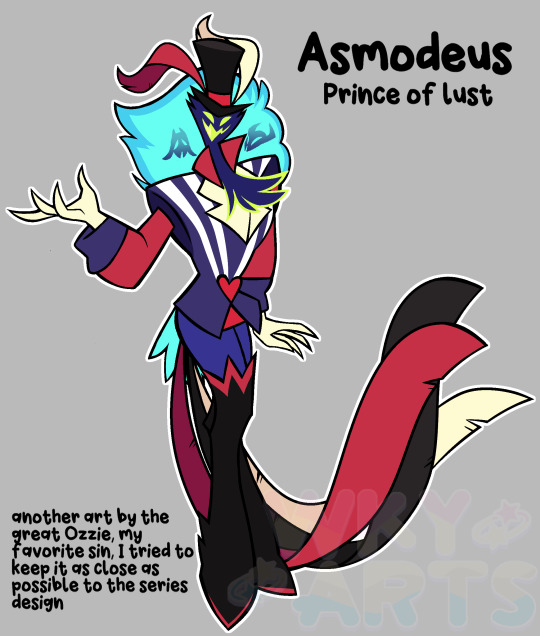
King Asmodeus "ozzie" 🐓👑
prince and embodiment of lust
mythology:
Asmodeus (in Greek: Ασμοδαῖος) is a character from the second part of the Book of Tobit, described as a demon whose role is to hinder the consummation of the marriage of the character Sarah, daughter of Raguel
The figure of Asmodeus is linked to Avestic Ashmadaeva, the demon of wrath of Zoroastrianism, who personifies the main negative forces of Persian religion.[1]
In addition to being one of the 72 spirits of Solomon used in Goetia, Asmodeus holds the title of king and has 72 legions of inferior spirits, he is the 32nd spirit in Goetia.
lore:
asmdoeus is the ruler of the lust ring , being the "weakest" infernal prince (according to what crimson says ) ,his job is to create new ways of giving pleasure to his incubus and other inhabitants in hell, having factories to create sex toys, etc., he dates a little imp called fizzrolli
.
I made a small change to Asmodeus's legs because I didn't like the fact that they were so thin, please don't bother me

Leviathan "Levy" 🐍🌊
prince and embodiment of envy
mythology:
Leviathan (Hebrew: לִוְיָתָן; roman: Livyatan, Liwyāṯān) is a fierce fish mentioned in the Tanakh, or Old Testament. It is a creature that, in some cases, can have a mythological or symbolic interpretation, depending on the context in which the word is used. It is usually described as having large proportions.
lore:
Leviathan is the supreme ruler of the ring of envy, I don't know for sure how the ring of envy itself would work but I believe it is a large ocean with cities in it
He is responsible for fashion and social networks in hell, having the function of dictating trends, thereby sowing envy and disagreement among lesser demons.
it has a smaller, more versatile form, which its symbol represents
This design is not official so don't bother me

Belphegor "bell" 💊😴🐐
princess and embodiment of sloth
mythology:
Belfegor (Belphegor; "the lord of fire") is a Moabite deity venerated on Mount Fegor. In Christianity, he is considered the demon of laziness, discoveries, rot, inventions, creativity and cycles.
lore:
she is the dominant figure in the ring of laziness, owning several factories and laboratories to create medicines and drugs, her sin is followed when you fail to do something important so it takes you out of your comfort zone
an example of this is avoiding saving someone's life because it would hinder you
belphegor is a close friend of bee-lzebub but their relationship has not yet been shown in the series
This design is not official so don't bother me
#helluva boss#helluva boss oc#hazbin hotel#hazbin hotel oc#hazbin hotel lucifer#helluva boss mammon#helluva boss asmodeus#helluva boss beelzebub#helluva boss leviathan#helluva boss azazel#helluva boss belphegor#helluva boss satan
196 notes
·
View notes
Text
Nobunaga and the "Dairokuten Maō faith"
This was described in a tourism website, so it might not be necessarily true. That being said, the article claimed that the reason why Nobunaga called himself the "Dairokuten Maō" was because he might be someone who is a participant of the Dairokuten Maō worship/faith.
To explain this a little: I once mentioned that the Dairokuten Maō is actually worshipped in some areas. There are various possible reasons, but one possible reason is that in non-Buddhist faiths, this "demon king" is viewed as a guardian.
As a demon, the Maō tempts people away from Buddhist enlightenment by worldly possessions. Gold and riches and lustful pleasure. Therefore, if someone doesn't believe in Buddhism, it would make sense for them to think that this is actually a good thing and perceive the Maō as some kind of god of prosperity instead.
Slightly related to the above, there were also some medieval texts linking the Dairokuten Maō to Amaterasu and/or other deities. I'm not sure if this is in any way relevant to the worship of the Maō, but it might be relevant to Nobunaga's actions.
This is a narrative that supposedly came from the Taiheiki (possibly a more modernised translation):
「イザナギ・イザナミの第一の御子神が、「この国の主と成て」���勢に鎮座したとき、第六天魔王が現れた。魔王は、この日本の国に仏法が広まると力を失うという理由から、天照大神の働きを妨害しようとした。
そこで天照大神は、魔王に「私は仏・法・僧の三宝には近づかない」と誓った。魔王は怒りを鎮め、その血で契約書を書き、天照大神に手渡した。「世界が滅び去るまで天照大神の末裔をこの国の主とする。もし、天皇の命に従わず、国を乱し、人民を苦しめるものがあれば、魔王の眷属が必ず罰を与え、死をもって報いさせよう」
[太平記]
When Izanagi and Izanami's first deity offspring "became the ruler of this land" and settled down in Ise, the Dairokuten Maō appeared. Since he would lose his power if Buddhism spread throughout the land of Japan, the Maō attempted to interfere with Amaterasu Ōmikami's actions.
Therefore Amaterasu Ōmikami swore to the Maō, "I will not come near the Three Treasures of Buddhism; the Buddha, Dharma, and the monks". The Maō's anger was appeased, and he wrote a contract in his blood which he gave to Amaterasu Ōmikami. "Until the world perishes, the descendants of Amaterasu Ōmikami shall be the rulers of this land. Supposing that anyone disobeys the Emperor's order, disturbs the country, or causes suffering to the people, the Maō's kin and house will surely punish them and repay it with death."
Some articles I've seen claim that there are also similar narratives where the ones who made the deal with the Maō were Izanagi and Izanami instead. As they were the creator-gods, this version escalates the Maō's importance even further. Though, I haven't seen any quotes of the actual text of this version yet.
The Taiheiki is a classic that I would expect the samurai lords of Nobunaga's time are familiar with. The idea that Nobunaga called himself the Dairokuten Maō based on the above Taiheiki text would lend some credence to the theories saying that Nobunaga might have been aiming to abolish the shogunate to restore power to the emperor.
As seen above, the Maō proclaims to be the emperor's protector, and also someone who safeguards peace in the nation. Even if Nobunaga doesn't particularly worship the Maō, he might have been inspired to view himself as that "Maō's kin and house" who puts to death those who disturbs the nation in service to the emperor.
Edit: It slipped my mind a little when I was originally writing this, but the argument against this would be that at the time of the Enryakuji burning, the head abbot of the temple was actually the emperor's brother. Nobunaga's attack on Enryakuji can be perceived as slight against the imperial household.
On the other hand, you could also argue that the Maō's protection only extends to the sitting emperor. Therefore, if Nobunaga was acting based on the Maō's promise written in Taiheiki, attacking Enryakuji is not against that principle.
#oda nobunaga#dairokuten maou#dairokuten maoh#demon king of sixth heaven#demon king of the sixth heaven#japanese history#sengoku#sengoku period#sengoku era#samurai#warring states#warring states era#warring states period#theory#feudal japan
15 notes
·
View notes
Note
it's speculative lore questions time ... no need to answer, since these sort of questions can get spoiler-y, i'm just very much kicking my feet anf giggling about this game
1. Is Watcher!Grian a thing? Or does he have any other watcher-related history? Does WC know? Does anybody know? Would this have any effect on his, say, moveset or knowledge of things?
2. Either way, is Grian still the creator of the games? Have the Watchers hijacked it or was it all the Watchers in the first place? (Dude loses his game and goes whoops. Fuck me I guess. I suppose it's a torture maze now)
3. What about Martyn's Eyes and Ears AU? Will aspects be pulled from that? Say, for example, the falling scene - is that something we see, is that a relevant character who speaks to him? Or is EnE mostly ignored (bc. yk. it's technically an AU anyways)?
4. How do the Watchers operate? Are they like a big pantheon that works together or are they more individualistic? Or would you compare them more with a cult? Are the members often seen as Gods or are they just god-like entities functioning as a group? What about senior figures vs the WC - how do they treat each other?
5. crumbs for me ..? what does the watcher child look like ..? appearance description for a poor boy ..? sir, could i please have some more ..? my name is oliver twist and i like silly fictional character appearance descriptions ..?
Hi-hey-hello! Arto and group here to answer!!
Watcher!Grian isn't as much of a thing, but he is very much more aware about the Watchers and who they are compared to everyone else. There is a hint of Watcher relation at the end. Grian used to be a Watcher, but was more of an apprentice than a fully fledged watcher; in-between the stages of Watcher Child and an actual Watcher. He was rid of his powers as soon as he entered 3rd Life. But as the series goes on, he gets slightly more and more Watcher possessed---to become a window for them to watch and keep an eye on everyone. The only time he breaks away from it is Wild Life! Wow that was a lot of watcher in this paragraph,,
Grian was the suggester of the games, but did not run them. The Watchers took his idea and claimed credit, turning it into a torture game for entertainment. Of course, it wasn't originally meant to be, which is why Grian knows the rules but wouldn't expect the horrors to come like the rest of the group.
Martyn's EnE AU will have slight involvement, fragment-wise. Three hearts symbolizing their lives will be placed on different parts of their body (for example, for Third Life, Martyn's hearts would be placed onto his cheek, which is also where his fragment goes (I think? I don't watch Martyn as often)).
How the watchers function as a society is more so unrevealed. All you really figure out is about TOPTS, The One Pulling The Strings. TOPTS is essentially a Watcher hivemind, connecting everyone. Though it lives and breathes, it's not necessarily alive, but is the only thing above the Watchers. Inside of TOPTS belongs the Source Code, aka the Heart. Now I thought of the name Source Code, it felt really familiar to smth else so that name might change lol idk where I got it from. Anyways, the Source Code is the very thing that channels all life---the reason of the Watchers, Lifers, and other creatures' existences. But it can get corrupted, and everything can go awry, so it'd not invincible.
Well, it's more of a beta design (have to confirm with others), but this is how I draw them!


I forgot their little halo on the second one, whoops!
They are feminine, but not a girl whatsoever. Watchers don't really have a concept of gender because yk theyre kind of deities, but Watcher Children can have human ish traits as they're not fully fledged Watchers and can only take their Creature Form.
Another thing is that the Watcher Realm is so incredibly random, they try to create it off of Earth. So there will be fake, purple plants, and giant, "bustling" cities (that are completely empty) with "greenery" right next to a literal wasteland o a desert. And then right next to that, is a beautiful, even MORE fake ocean that doesn't even continue. It just stops really abruptly. Not really a lake, completely like an ocean, except at some point it just cuts off and theres just a wall of water. Its a bit hard to explain LOL but I hope your questions were answered!!
- Arto, Kori and Pinkish
15 notes
·
View notes
Text
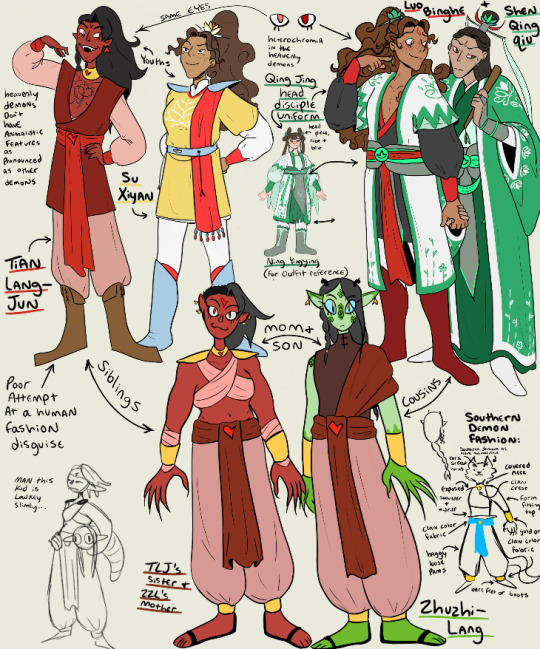
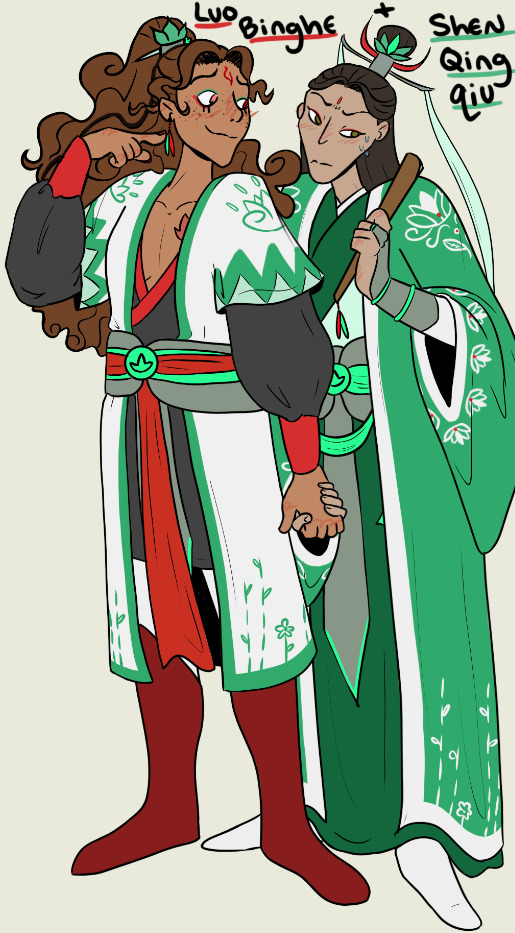

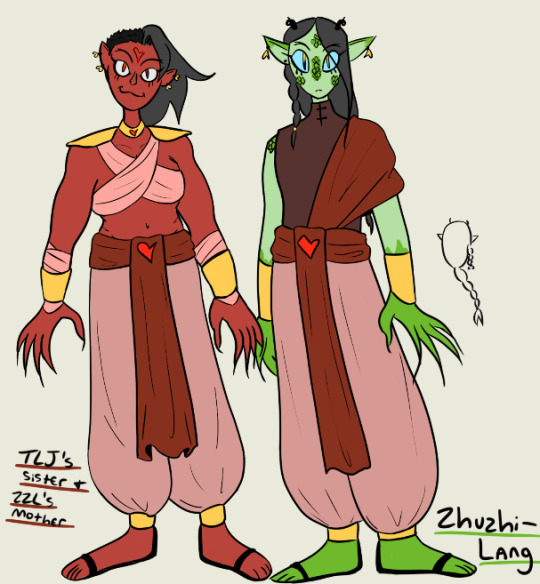
Part one of a mini Scum Villain design series I've been doing between work and assignments recently, mainly on the demons and their looks and fashion. First up: Luo Binghe's extended family. I've included some sketches and notes in that main picture, but I'll include some thoughts beneath the read more for if anyone is interested. Just keep in mind these are all head canons based on. my brain. and get a bit over explained and in depth (to the tune of 1k words) (in theory these is a read more here but uhhh rip):
Also keep in mind idk the official fashion names for stuff so I call things belts, robes, pants, ect even when that may not be the official term. if you know the official terms or even have guides or references I can use then please hmu and I will love you forever. Anyways:
Since TLJ ruled the southern kingdom and MBJ ruled the north, I've primarily divided the demon variants to be based around the directions. For most demons, I've got them in "clans" that really just denote what color fabric their belt is and what the design/color of the crest featured on most of them is. I imagine those sorts of simple visual signifiers make it easier for demons, especially lower class ones who may be unable to read, to identify friend or foe at a glance. I also wanted to have the demons wearing jewelry much more prominently than the humans do. As in like, the human fashion sense trends towards sensible, refined, and modest, and the demon fashion sense tends towards ostentatious, lax and boastful, though that ofc doesn't apply to everyone. This sorta stuff gets more relevant later for the designs of demons like Six Balls and Meng Mo.
For these lads (sans Binghe), they're southern demon based, as shown by the little cat demon design at the bottom right. Completely arbitrarily and just for the fun of it, I've got their primary clothing choices as being warm color fabrics paired with gold as a metal, form fitting tops with exposed stomachs, and baggy pants. Looser lighter fabrics allow for more flexibility for animalistic features or and body transformations that may happen. They're also typically in open toed shoes for similar reasons. Only Zhuzhi in this lineup has mini little horns, but I've also assigned each region a general horn shape (so edged and jagged for the north, spiral for the south, straight for the east and curved and wavy for the west). The only thing Binghe adopts from any demon style is the exposed chest, cloth on the belt, colors, and the demon mark.
I like giving the demons openly animalistic and beast like features, like colored skin, horns, fur/feathers/scales, claws, three fingers, ect, which again comes into play for the later demon designs I'm gonna post. For heavenly demons, however, since they're ancient fallen deities, I wanted them to skew more towards a human appearance. So while they have more vibrant skin and eyes, or sharper ears and fingers, they wouldn't have to put too much effort into a disguise or glamour to come off as a human.
Anyways, onto actually explaining what's happening in the pictures:
TLJ is attempting to appropriate human fashion choices, but has no idea what the line is. Like, he's aware they wear more fabric than demons, and have sleeves that fully cover their arms, but has no clue what pieces pair together and what fashion choices are clearly demon related that would get him recognized immediately. Like "what do you mean human's don't wear their clan crests everywhere? well how else do they define their enemies?!" Su Xiyan, meanwhile, is dressed in Huan Hua clothing. I wanted to make them distinct visually from Cang Qiong, so currently I have CQ having each peak have its own colors of robes (patterns and such denoting ranking), with each peak generally having a similar look and all of them (sans peak lords) wearing identical belts and boots, with the only variations being colors. Meanwhile, I have Huan Hua having everyone in the same gold silver white uniforms, with ranking denoted by accent colors and accessories they choose to wear. Like, if she was more self absorbed here, Su Xiyan could have worn a longer robe and a cape over that uniform but just chose not to. I like the idea of them wanting all their people to look the same, like an army or a hivemind.
Going to the bottom there: TLJ's Sister and ZZL's mother...what a figure. Like what was up with her. Like TLJ saying "if i had a mother like that I'd want to forget her too" like is that in reference to the abandonment or to her being a piece of work? Also, how on earth did the little sister of Mr "I'm so powerful a multi sect ambush of the top cultivators was only enough to imprison me" TLJ just casually died?? Like can heavenly demons even do that??? I love making up wild conspiracies about her based on nothing. She faked her death. She didn't die, she ascended to godhood as the god of deadbeat parents, or perhaps snake lovers. She dropped her mortal body to enter the dream realm like Meng Mo did and that's how she told TLJ her wish for ZZL. Wild. Oh also my other wild conspiracy is that she had more than one kid and thus there are a bunch of unclaimed half heavenly demons running around. Banging a snake man and ditching the kid?? Ain't no way that's her first time. Anyways.
My only comments on Zhuzhi are that I wanted to make him look like a little guy. And I hope I succeeded. Oh and also that his cheeks, nose, forehead, shoulder, hands, and feet are darker bc thats a cluster of harder scales he retains even in a humanoid form. Anyways.
Onto bingqiu: I've seen some art of Binghe in that white robe on top of his darker ones and had the thought that it'd be nice if that was the Qing Jing inner disciple robe, so I leaned into that. Their robes (as also shown on the little Ning Yingying next to him) are like a shorter color swapped version of the peak lord robes, and they're wearing similar belt and hair crowns. I think Binghe would wanna wear them partially to show off his disciple status and partially to wear the colors of his husband (like with the upper eyeliner), though he still has demon traits and fashions showing. I gave TLJ and LBH heterochromia since I wanted it to be immediately obvious to anyone who looked at them that yeah, they have the same eyes. Binghe's everything else is just slight adjustments of SXY, like the nose and the fluffy hair. Meanwhile, I've got SQQ in mainly his peak lord robes, with a few exceptions: The tassel on the closed fan he's holding is the same as Binghe's earring, he's wearing red eyeliner, and part of his hair crown is red. Also he's embarrassed about the pda (h*lding h*nds in public), that nervous expression isn't bc he was forced to do anything he doesn't want to.
Anyways to wrap up this one thousand word brain ramble, I have a lot of thoughts on world building for fleshing things out, and part two of this will be focused on Mobei Jun, thanks for reading
#svsss#scum villain self saving system#scum villain#scum villain fanart#svsss fanart#tianlang jun#su xiyan#luo binghe#shen qingqiu#zhuzhi lang#my art tag#my svsss char design series
105 notes
·
View notes
Note
Is there any information about Mukishanu outside of his roles in the Song of Hedammu and Song of Ulikummi? I'm assuming there's little to nothing, but but I'm curious either way.
There indeed isn’t much otherwise. As far as I am aware, the brief survey given by Gernot Wilhelm in the Reallexikon is still up to date.
All of the available attestations of Mukishanu come from Hattusa - from Hurrian or at least Hurrian-adjacent sources. The bulk of them are passages from Song of Hedammu and Song of Ullikummi, plus some which according to Wilhelm cannot be placed in either with certainty but belong to the same cycle at the very least. As far as I know, none of these ever go beyond the usual formula “Kumarbi repeats a message he wants to send, Mukishanu leaves to deliver it”.
On top of the literary sources there is a single ritual text which mentions Mukishanu, a list of offerings connected with the cult of Shaushka of Samuha (CTH 712). It’s a peculiar oddity in that every single deity listed in the relevant passage is a sukkal, and explicitly identified as such. I’m not aware of any parallels to this from any part of the “cuneiform world”. The ritual is not very informative, though, it just repeats the formula “a flatbread for x sukkal of y”. No reason is given for gathering attendant deities like that. Perhaps they’re unionizing or something.
More under the cut, including some speculation.
Wilhelm doesn’t discuss CTH 712 beyond Mukishanu’s appearance in it, but it’s not hard to find a full list of the deities invoked, for example here, p. 370: Undurumma (Shaushka’s), Tenu (Teshub’s), Mukishanu (Kumarbi’s), Izzumi (ie. Mesopotamian Isimu/Usmu; Ea’s); Lipparuma (Shimige’s) and Ḫupuštukar (Ḫešui’s). Most of them are relatively well attested, but there are two peculiarities: Undurumma is pretty much unattested otherwise (in the overwhelming majority of ritual and literary texts and in visual arts Shaushka almost invariably appears with Ninatta and Kulitta, so you’d expect them to have this role, but nope) and Ḫešui is himself quite rare so learning he was major enough to have an attendant is quite surprising (granted, there is a theory he was worshiped more commonly earlier on or in different Hurrian communities as these which influenced the Hattusa archive). It also strikes me as odd that Hebat and Takitu are missing.
The only other information about Mukishanu comes from the etymology of his name. While he is attested exclusively in Hurrian and Hurro-Hittite sources, his name actually comes from a Semitic language (I am not aware of any more precise attempts at identification) and means something like “he from Mukish”. This term referred to the area around Alalakh. As discussed here (p.3 ) by Alfonso Archi, it essentially underwent cultural “Hurrianization”: by the fourteenth century, about three fourths of its inhabitants mentioned in textual sources bore Hurrian names, and the ritual text CTH 780 mentions an apparently famous Hurrian expert from Mukish, a certain ms. Allaituraḫḫi. The calendar was seemingly Hurrian too, though with one month name - Pagri - goes back to an Akkadian term (pagrum, a ceremony for the dead).
We don’t have much in the way of religious texts from Alalakh. The local pantheon attested in royal documentation was discussed briefly in Volkert Haas’ Geschichte der hethitischen Religion (p. 556-557). There is evidence for Teshub, Ishara/Shaushka/Ishtar (the writing is logographic and notoriously hard to untangle in this case; I think the evidence for Ishara is the strongest), Hebat, Kubaba, Umbu (a moon god or at least a name of the Hurrian moon god) and earth and heaven. There is also at least one reference to the worship of Kumarbi as well, and to a temple of a deity named Kūbi, see here, p. 207. Mukishanu is notably absent, though, and I haven’t really seen any proposals regarding this state of affairs. I personally see two possible solutions: Mukishanu was an epithet or generic designation which developed into a separate deity; or alternatively he represented the image of inhabitants of Alalalkh in the eyes of another group (much like how Amurru was not actually an Amorite god despite his name). However, this is just my own speculation. It’s also worth noting that Gary Beckman at least seems to imply he assumes Mukishanu was actually worshiped in Alalakh or somewhere nearby, since he counts his presence in the Kumarbi cycle as an argument for seeking its origin across Upper Mesopotamia and northern Syria rather than in Anatolia here (p. 25).
7 notes
·
View notes
Text
@billy-royalton Sorry, but I couldn't reply to your question directly for some reason... Gotta go right now, so I typed this in a hurry, hope there aren't many typos and it's easy to understand! Xo 💗
Short Answer: Yes and yes. I've read all of the books, including the crossovers with the Mayfair Witches and New Tales of the Vampires (Pandora and Vittorio, the Vampire). Here's what I can tell you about these novels and how I feel about them…
Merrick: It is the most important book among the three. There are very important events regarding Louis and Claudia. The show has adapted some of that already (him walking into the sun on 2x05), but there might be more as soon as season 3 arrives. There's also a lot of Merrick and David on it, though I don't know if they will be written into the show or not (and if they do, I don't know how it will be). The writing for Merrick has a number of racial stereotypes, offensive lines and I don't know how accurate Anne's portrayal of candomble and voodoo was (based on what I know about umbanda, the only thing I know she got right was the name of certain deities). However, I believe Merrick is a great character, I fell in love with her and she's one of my favorites. Her family is a long line of witches and I was extremely intrigued by them. I understand why some people couldn't like the book, though. Because whether Anne meant it or not, it was indeed offensive. Still, I don't believe that ever ruined Merrick as a character or her personality. She was super likeable and compelling. My problem was more with the way David and Aaron acted and talked about her than her own behavior, if that makes sense. For me, the downside of this volume was having David's POV (he is one of the weakest narrators, I wish it was MERRICK's so I could see more of her or Lestat's), little Lestat and no Armand (I ALWAYS want to see him).
Blackwood Farm: The only main character on this one is Lestat and he doesn't appear as much. The story is mostly about this new character named Quinn (and to some extent, Mona Mayfair). I enjoyed it, and it was really creative, peculiar and dark in some aspects. His narration is O.K. There were some scenes here and there that were compelling. And there was a character who was intersex/gender-fluid and used multiple pronouns called Petronia that I really loved, even though they were… Well, complicated. I don't wanna spoil those stuff for you, but I could still empathize with them a lot, because they had such a tragic story that I believe explained a lot of their actions, just like how I feel about Armand and Lestat.
Blood Canticle: It is another book where only Lestat, Quinn and Mona show up. Quinn falls more to the back on this one, while Lestat, Mona and Rowan Mayfair are more present in the narrative. The plot didn't make a lot of sense for me and Rowan is probably the only female I never cared about, even if her story was appealing. Because the way I felt about her was close to how I felt about Louis on Merrick, like, you're a relevant character and big, dark, tragic things happened to you… But I just don't care. I did love Mona and Lestat entertained me because there was a lot of humor from him too. There are parts that he is rambling about becoming a saint and it's ridiculous and hilarious, it was very Lestat of him and I was laughing out loud late at night. I also enjoyed Lestat and Mona together, they had sort of a sibling-like rivalry and their childish bickering entertained me. There were times that Mona humbled him and I was shocked that she actually went there and threw certain stuff on his face. I was like, NO, YOU DIDN'T? OMG! And that girl is joining Lestat and Armand in the BPD squad, she might actually be worse than them. Lestat complaining about her had me like, sweetie, the call is coming from inside the house. So, it wasn't brilliant, some stuff were weird and nonsensical, but it was fun. This is also the only crossover I found a physical copy of, the others I read on my mobile so I can't talk about their length, but this one didn't even have 300 pages. It was a fast read for most of the time.
Conclusion? They aren't on my top 4, but I didn't struggle with them as I did with Memnoch the Devil or even Interview With the Vampire (I only liked Claudia and Armand on it), for that matter. I believe Merrick and Blackwood Farm are better than Blood Canticle, but it's hard to quantify and qualify the novels outside of my top 4 (TVA, TVL, Prince Lestat, TQOTD). Some might be better than others, but the difference isn't as huge as it is with those four, they're way above the rest (but I also love Vittorio and Pandora, people sleep on them, but they would be tied as my top 5). They didn't give me a lot of goosebumps and didn't leave a huge impact on me, but were mostly fine and some scenes, characters and dynamics were interesting. They're not necessary to read, though, except for maybe Merrick, so you can skip at least 2/3 and be fine… So just figure out what works for you and you'll be alright. Anyway, I hope this amount of information works for you and if you have any more questions, feel free to ask away!
6 notes
·
View notes
Text
The Yaga journal: Witches and demons of Eastern Europe
The next article I’ll translate from the issue (I won’t translate all of them since some are not very relevant for this blog) is “Baba Yaga, witches, and the ambiguous demons of oriental Europe” by Stamatis Zochios.
The article opens by praising the 1863′s “Reasoned dictionary of the living russian language”. by scholar, lexicograph and folklorist Vladimir Dahl, which is one of the first “systematic essays” that collects the linguistic treasures of Russia. By collecting more than thirty thousand proverbs and sayings, insisting on the popular and oral language, the Dictionary notably talked about various terms of Russian folklore; domovoi, rusalka, leshii... And when it reaches Baba Yaga, the Dictionary calls her : сказочное страшилищ (skazochnoe strashilishh) , that is to say “monster of fairytales”.But the article wonders about this denomination... Indeed, for many people (such as Bogatyrev) Baba Yaga, like other characters of Russian fairytales (Kochtcheï or Zmey Gorynych) do not exist in popular demonology, and is thus exclusively a character of fairy tales, in which she fulfills very specific functions (aggressor, donator if we take back Propp’s system). But the author of this article wonder if Baba Yaga can’t actually be found in “other folkloric genres” - maybe she is present in legends, in popular beliefs, in superstitions and incantations.
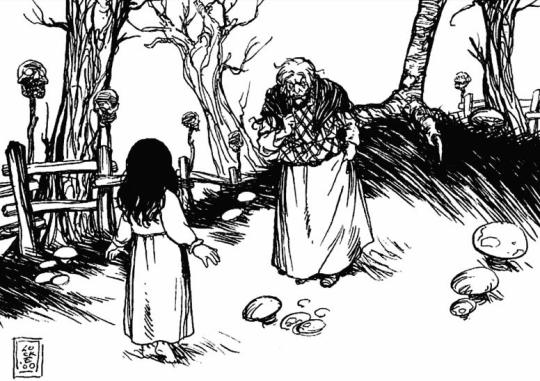
Baba Yaga, as depicted in the roleplaying game “Vampire: The Masquerade”
For example, in a 19th century book by Piotr Efimenko called “Material for ethnography of the Russian population of the Arkhangelsk province”, there is an incantation recorded about a man who wante to seduce/make a woman fall in love with him. During this incantation the man invokes the “demons that served Herod”, Sava, Koldun and Asaul and then - the incantation continues by talking about “three times nine girls” under an oak tree”, to which Baba Yaga brings light. The ritual is about burning wood with the light brought by Baba Yaga, so that the girl may “burn with love” in return. Efimenko also mentions another “old spell for love” that goes like this: “In the middle of the field there are 77 pans of red copper, and on each of them there are 77 Egi-Babas. Each 77 Egi-Babas have 77 daughters with each 77 staffs and 77 brooms. Me, servant of God (insert the man’s name here) beg the daughters of the Egi-Babas. I salute you, daughters of Egi-Babas, and make the servant of God (insert name of the girl here) fall inlove, and bring her to the servant of God (insert name of the man here).” The fact Baba Yaga appears in magical incantations proves that she doesn’t exist merely in fairytales, but was also part of the folk-religion alongside the leshii, rusalka, kikimora and domovoi. However two details have to be insisted upon.
One: the variation of the name Baba Yaga, as the plural “Egi-Babas”. The name Baba Yaga appears in numerous different languages. In Russian and Ukrainian we find Баба-Язя, Язя, Язі-баба, Гадра ; in Polish jędza, babojędza ; in Czech jezinka, Ježibaba meaning “witch, woman of the forest”, in Serbian баба jега ; in Slovanian jaga baba, ježi baba ... Baba is not a problem in itself. Baba, comes from the old Slavic баба and is a diminutive of бабушка (babyshka), “grand-mother” - which means all at the same time a “peasant woman”, “a midwife”, a (school mistress? the article is a bit unclear here), a “stone statue of a pagan deity”, and in general a woman, young or old. Of course, while the alternate meanings cannot be ignored, the main meaning for Baba Yaga’s name is “old woman”. Then comes “Yaga” and its variations, “Egi”, “Jedzi”, “Jedza”, which is more problematic. In Fasmer’s etymology dictionary, he thinks it comes from the proto-Slagic (j)ega, meaning “wrath” or “horror”. Most dictionaries take back this etymology, and consider it a mix of the term baba, старуха (staruha), “old woman”, and of яга, злая (zlaia), “evil, pain, torment, problem”. So it would mean злая женщина (zlaja zhenshhina), “the woman of evil”, “the tormenting woman”. However this interpretation of Yaga as “pain” is deemed restrictive by the author of this article.
Aleksandr Afanassiev, in his “Poetic concepts of the Slavs on nature”, proposed a different etymology coming from the anskrit “ahi”, meaning “snake”. Thus, Baba Yaga would be originally a snake-woman similar to the lamia and drangua of the Neo-hellenistic fairytales and Albanian beliefs. Slavic folklore seems to push towards this direction since sometimes Baba Yaga is the mother of three demon-like daughters (who sometimes can be princesses, with one marrying the hero), and of a son-snake that will be killed by the hero. Slovakian fairytales tale back the link with snakes, as they call the sons of Jezi-Baba “demon snakes”. On top of that, an incantation from the 18th century to banish snakes talks about Yaga Zmeia Bura (Yaga the brown snake): “I will send Yaga the brown snake after you. Yaga the brown snake will cover your wound with wool.” According to Polivka, “jaza” is a countryside term to talk about a mythical snake that humans never see, and that turns every seven years into a winged seven-headed serpent. With all that being said, it becomes clear (at least to the author of this article) that one of the versions of Yaga is the drakaina, the female dragon with human characteristics. These entities are usually depicted with the head and torso of women, but the lower body of a snake. They are a big feature of the mythologies of the Eurasian lands - in France the most famous example is Mélusine, the half-snake half-woman queen, whose story was recorded between the end of the 14th century and the beginning of the 15th by Jean d’Arras (in his prose novel La Noble Histoire de Lusignan) and by Couldrette (in the poetic work Roman de Mélusine). For some scholars, these hybrid womans are derived from the Mother Goddess figure, and by their physical duality manifest their double nature of benevolence-malevolence, aggressor-donator.
If we come back to the incantation of Efimenko, we notice that the 77 daughters of Baba Yaga each have a “metly”, a “broom”. This object isn’t just the broom Baba Yaga uses alongside her mortar and pestle to travel around - it is also the main attribute of the witches, and the witch with her broom is a motif prevalent in numerous textes of Western Europe between the 15th and 16th centuries. Already in medieval literature examples of this topic could be found: in the French works “Perceforest” and “Champion des dames”, the old witches are described flyng on staffs or brooms, turning into birds, to either eat little children or go to witches’ sabbaths. Baba Yaga travels similarly: Afanassiev noted that she goes to gathering of witches while riding a mortar, with a pestle in one hand and a broom in the other. Federowsky noted that Baba Yaga was supposed to be either the “aunt” or the “mistress” of all witches. Baba Yaga herself in often called an old witch, numerous dictionaries explaining her name as meaning старуха-колдунья (staruha-koldun’ja), which literaly means old witch. Even more precisely, she is an old witch who kidnaps children in order to devour their flesh and drink their blood. We find back in other countries of Europe this myth of the “bogeywoman cannibal-witch”, especially dangerous towards newborns and mothers, as the “strix” or “strige”. According to Polivka, in his 1922 article about the supernatural in Slovakian fairytales, the ježibaba is the same being as the striga/strige. And he also ties these two beings to the bosorka, a creature found in Slovakia, in eastern Moravia, and in Wallachia, and which means originally a witch or a sorceress, but that in folklore took a role similar to the striga or ježibaba.
Vinogradova, in a study of the figure of the bosorka, described this Carpathian-Ukrainian witch as a being that attacked people in different ways. For example she stole the milk from the cows - a recurring theme of witches tales in Western Europe (mentionned by Luther in his texts as to one of the reasons witches had to be put to death), but that also corresponds to a tale of the Baba Yaga where she is depicted as sucking the milk out of the breast of a young woman (an AT 519 tale, “The Strong Woman as Bride”). In conclusion, the striga-bosorka is clearly related to the Slovakian version of Baba Yaga, the Ježibaba. The Ježibaba, a figure of Western Slavic folklore, also appears as numerous local variations. She is Jenzibaba, Jendzibaba, Endzibaba, Jazibaba, and in Poland she is either “jedza-baba” (the very wicked woman) or “jedzona, jedza-baba, jagababa” (witch). However this Slovakian witch isn’t always evil: in three fairytales, Ježibaba is a helper bringing gifts, appearing as a trio of sisters (with a clear nod to the three fatae, the three moirae or the three fairies of traditional fairytales) who help the hero escape an ogre who hunts him. They help him by gifting him with food, and then lending him their magical dogs. And in other farytale, the three sisters help a lazy girl spin threads.
In this last case, Ježibaba is tied to the action of spinning. It isn’t a surprise as Baba Yaga herself is often depicted spinning wool or owning a loom ; and several times she asks the young girls who arrive at her home to spin for her (AT 480, The Spinning-Woman by the Spring) - AND in some variations, her isba doesn’t stand on chicken legs, but rather on a spindle. This relationship between the female supernatural figure (fairy or witch) and the action of spinning is very typical of European folkore. In several Eastern Slavic traditions, the figure of Paraskeva-Piatnitsa (or Pyatnitsa-Prascovia, who is often related to Baba Yaga), is an important saint, personification of Friday and protectress of crops - and she punishes women who dare spin on the fifth day of the week. Sometimes it is a strong punishment: she will deform the fingers of the woman who dares spin the friday, which relates her to the naroua (or naroue, narova, narove) a nocturnal fairy of Isère and Savoie in France, who manifests during the Twelve Days of Christmas and enters home to punish those that work at midnight or during holidays - especially spinners and lacemakers. In a Savoie folktales she is said to beat up lacemakers until almost killing them, hits them on the fingers with her wand, beats them up with a beef’s leg or a beef’s nerves, and attacks children with both a cow’s leg in one hand and a beef’s leg in another. These bans are also found in the Greek version of Piatnitsa: Agia Paraskevi, Saint Paraskevi, who punishes the spinners that work on Thursday’s nights, during Friday, or during the feast-day of the Saint (26 of July). But her punishment is to force them to eat the flesh of a corpse. Finally, we find the link between spinning and the demonic woman/witch/fairy through the Romanian cousin of Baba Yaga - Baba Cloanta, who says that she is ugly because she spinned too much during her life. And it all ties back to the “Perceforest” tale mentionned above - in the text, the witches, described as old matrons disheveled and bearded, not only fly around on staffs and little wooden chairs, but also by riding on spindles and reels/spools.
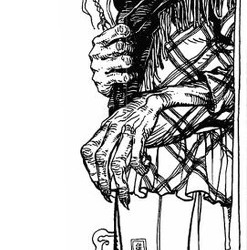
Another typical example of “demonic woman” often compared and related to Baba Yaga is the character known as “Perchta” in her Alpine-Germanic form, Baba Pehtra in Slovenia, or Pechtrababajaga according to a Russian neologism. The name Perchta, Berchta, Percht, Bercht comes from the old high German “beraht”, of the Old German “behrt” and of the root “berhto-”, which is tied to the French “brillant” and the English “brilliant”. So Berchta, or Perchta, would mean “the brilliant one”, “the bringer of light”. Why such a positive name for a malevolent character?
In 1468, the Thesaurus pauperum, written by John XXI, compares two fairies with a cult in medieval France, “Satia” and “dame Abonde”, with another mythological woman: Perchta. The Thesaurus pauperum describes “another type of superstition and idolatry” which consists in leaving at night recipients with food and drinks, destined to ladies that are supposed to visit the house - dame Abonde or Satia, that is also known as “dame Percht” or “Perchtum”, who comes with her whole “troop”. In exchange of finding these open recipients, the ladies will thenfill them regularly, bringing with them riches and abundance. “Many believed that it is during the holy nights, between the birth of Jesus and the night of the Epiphany, that these ladies, led by Perchta, visit homes”, and thus during these nights, people leave on the table bread, chesse, milk, meat, eggs, wine and water, alongside spoons, plates, cups, knives, so that when lady Perchta and her group visit the house, they find everything prepared for them, and bless the house in return with prosperity. So the text cannot be more explict: peasants prepared meals at night for the visit of lady Perchta, it is the custom of the “mensas ornare”, to prepare the table in honor of a lady visiting houses at night. If she finds offerings - cuttlery, drinks, food, especially sugary food - she rewards the house with riches. Else, she punishes the inhabitants of the home.
But Perchta doesn’t just punish for this missing meal. Several stories also describe Perchta looking everywhere in the house she visits, checking every corner to spot any “irregularity”. The most serious of those sins is tied to spinning: the woman of the house is forced to stop her work before midnight, or to not work on a holiday - especially an important holiday of the Twelve Days, such as Christmas or the Epiphany. If the woman is spotted working ; or if Perchta doesn’t found the house cleaned up and tidied up ; or if the flax is not spinned, the goddess (Perchta) will punish the woman. This is why she was called “Spinnstubenfrau”, “the woman of the spinning room”. It is also a nickname of a German spirit known as Berchta - as Spinnstubenfrau, she takes the shape of an old witch who appears in people’s houses during the winter months. She is the guardian spirit of barns and of the spinning-room, who always check work is properly and correctly done. And her punishment was quite brutal: she split open the belly of her victim, and replaces the entrails with garbage. Thomas Hill in his article “Perchta the Belly Slitther” sees in this punishment the remnants of old chamanic-initiation rite ; which would tie to it an analysis done by Andrey Toporkov concerning the “cooking of the child” by Baba Yaga in the storyes of the type AT 327 C or F. In these tales a boy (it might be Ivashka, Zhikharko, Filyushka...) arrives at Baba Yag’s isba, and the witch asks her daughter to cook the boy. The boy makes sure he can’t be pushed in the oven by taking a wrong body posture, and convinces the girl to show him how he should enter the oven. Baba Yaga shows him to do so, enters the oven, and the boy finds the door behind her, trapping Baba Yaga in the fire. According to Toporkov, we can find behind this story an old ritual according to which a baby was placed three times in an oven to give it strength. (The article reminds that Vladimir Propp did highlight the function of Baba Yaga as an “initiation rite” in fairytales - and how Propp considered that Baba Yaga is a caricature of the leader of the rite of passage in primitive societies). And finally, in a tale of Yakutia, the Ega-Baba is described as a chaman, invoked to resurrect a killed person. The author of the article concludes that the first link between Yaga and Perchta is that they are witches/goddesses that can be protectress, but have a demonic/punishment-aspect that can be balanced by a benevolent/initiation-aspect. But it doesn’t stop here.
The Twelve Days are celebrations in honor of Perchta, practiced in Germany, Austria and Switzerland. Still today, “Percht” is a term used to call masked person who haunt at night the villages of High-Styria or the land of Salzbourg: they visit houses while wearing masks, clothed in tatters and holding brooms. During these celebrations, young people either dress up as beautiful girls in traditional costumes (the schöne Perchten), either as ugly old woman (die schiache Perchten). These last ones are inspired by the numerous depictions of Perchta as an old woman, or sometimes a human-animal hybrid, with revolting trait - most prominent of them being the feet of a goose. This could explain in Serbia the existence of a Baba Jaga/Baba Jega with a chicken feet, or even the chicken feet carrying the isba of Baba Yaga. This deformation also recalls a figure of the French region of Franche-Comté, Tante Arie (Aunt Arie), another supernatural woman of the Twelve Days tied to spinning. The second most prominent trait of the “old Perchta” is an iron nose - already in the 14th century, Martin of Amberg wrote about “Percht mit der eisnen nasen”, “Percht with an iron nose”. Yaga also sometimes hag an iron nose, and this is why she was associated with other figures of Carpathian or Western Ukraine folklores - such as Zalizna baba or Zaliznonosa baba, the “old woman of iron”, who lives in a palace standing on duck legs ; there is also Vasorru Baba, the iron-nosed woman of Hungaria. Or Huld - another Spinsstubenfrau, often related to Perchta, but who has more sinister connotations. Huld has an enormous nose according to Luther, and Grimm notes that sometimes she appears as a witch with one very long tooth. This last characteristic if also recurring in Eastern Europe’s mythologies: in Serbia Gvozdenzuba (Iron Teeth) is said to burn the bad spinners ; and Baba Yaga is sometimes described with one or several long teeth, often in iron. But it is another aspect of the myths of Huld, also known as Holda or Frau Holle, that led the scholar Potebnja to relate her to Perchta and Baba Yaga.
According to German folk-belief, Huld (or often Perchta) shakes her pillowcases filled with feathers, which causes the snow or the frost ; and thunder rumbles when she moves her linen spool. It is also said that the Milky Way was spinned with her spinning wheel - and thus she controls the weather. In a very similar function, the Baba Jaudocha of Western Ukraine (also called Baba Dochia, Odochia, Eudochia, Dochita, Baba Odotia, a name coming from the Greek Eudokia) is often associated with Baba Yaga, and she also creates snow by moving either her twelve pillows, or her fur coat. According to Afanassiev, the Bielorussians believed that behind the thunderclouds, you could find Baba Yaga with her broom, her mortar, her magic carpet, her flying horses or her seven-league boots. For the Slovakians, Yaga could create bad or beautiful weather. In Russia, she is sometimes called ярою, бурою, дикою , “jaroju, buroju, dikoju”, a name connected to thunderstorms. Sometimes Yaga and her daughters appear as flying snakes - and the полет змея, the “polet smeja”, the “flight of the snake” was believed to cause storms, thunder and earthquakes. In a popular folk-song, Yaga is called the witch of winter: “Sun, you saw the old Yaga, Baba Yaga, the winter witch, this ferocious woman, she escaped spring, she fled away from the just, she brought cold in a bag, she shook cold on earth, she tripped and rolled down the hill.” Finally, for Potebnia, the duality and ambiguity of Baba Yaga, who steals away and yet gives, can be related to the duality of the cloud, who fertilizes the land in summer, and brings rain in winter. Baba Yaga is a solar goddess as much as a chthonian goddess - she conjointly protects births, and yet is a psychopomp causing death.
It seems, through these examples, that Baba Yaga is a goddess - or to be precise, a spirit of nature. Sometimes she is a leshachikha, the wife of the “leshii”, the spirit of the forest, and she herself is a spirit of the woods, living alone in an isolated isba deep in the thick forests. She is thus often paralleled with Muma Padurii, the Mother of the Forest of Romanian folklore, who lives in a hut above rooster’s legs, surrounded by a fence covered in skulls, and who steals children away (in tales of the type AT 327 A, Hansel and Gretel). This aspect of Baba Yaga as a spirit of the forest, and more generally as a “genius loci” (spirit of the place) also makes her similar to another very important figure of Slavic folklore: Полудница (Poludnica), the “woman of noon”. She is an old woman with long thick hair, wearing rags, and who lives in reeds and nettles ; or she can rather be a very beautiful maiden dressed in white, who punishes those that work at noon. She especially appears in rye fields, and protects the harvest. In other tales, she rather sucks away the life-force of the fields - which would relate her to some stories where Baba Yaga runs through rye fields (either with a scarf of her head, or with her hair flowing behind her). Poludnica can also look like Baya Yaga: Roger Caillois, in his article “Spectres de midi dans la démonologie slave” (Noon wraiths in the Slavic demonology), mentionned that Poludnica was a liminal deity of fields, to which one chanted полудница во ржи, покажи рубежи, куда хошь побѣжи !, “Poludnicaa in the rye - show the limits - and go where you want.” This liminal aspects reminds of an aspect of Baba Yaga as a genius loci, tied to a specific place that she defends. It is an aspect found as Baba Yaga, Baba Gorbata, Polydnitsa and Pozhinalka: Baba Yaga is either a benevolent spirit that protects the place and the harvest ; either she is a malevolent sprit that absorbs the life-force of the harvest and destroys it. This is why she must be chased away, and thus it explains a Slovanian song that people sing during the holiday of Jurij (the feast day of Saint George), the 23rd of April, an agrarian holiday for the resurrection of nature: Zelenga Jurja (Green George), we guide, butter and eggs we ask, the Baba Yaga we banish, the Spring we spread!”. This chant was tied with a ritual sacrifice: the mannequin of an old woman had to be burned. As such, Baba Yaga and her avatars, was a spirt that had to be hunted down or banned - which is a custom found all over Europe, but especially in Slavic Europe. At the end of the harvest, several magical formulas were used to push away or cut into pieces the “old woman” ; and we can think back of Frazer’s work on the figure of the “Hag” (which in the English languages means as much an old woman as a malevolent spirit), who is herself a dual figure. In a village of Styria, the Mother of wheat, is said to be dressed in white and to be born from the last wheat bundle. She can be seen at midnight in wheat fields, that she crosses to fertilize ; but if she is angry against a farmer, she will dry up all of his wheat. But then the old woman must be sacrificed - just like in the feast of Jurij.
The author concludes that the “folkloric” aspect of Baba Yaga stays relatively unknown in the Western world and the non-russophone lands. The most detailed and complete work the author could find about it is Andreas Johns’ book “Baba Yaga: The Ambiguous Mother and Witch of the Russian Folktale”. The author of the article tried to prove that, as Johns said, the Baba Yaga is fundamentaly ambiguous - at the same time a kidnaping witch, a psychopomp, a cannibal, a protectress of birth, a guardian of places, a spirit of nature and harvests... And that she is part of an entire web and system of demon-feminine figures that create a mythology ensemble with common characteristic - very present in Eastern Europe, but still existing on the continent as a whole.
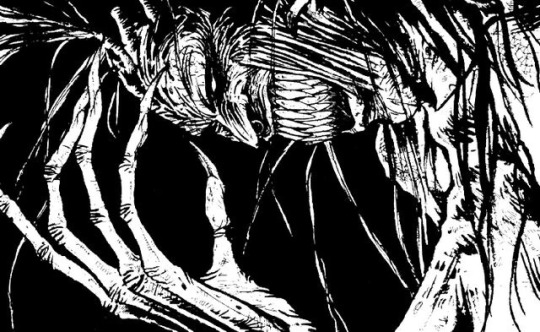
#the yaga journal#baba yaga#slavic folklore#eastern europe folklore#european folklore#perchta#fairies#fairy folklore#demonology#demons#witches
65 notes
·
View notes
Text
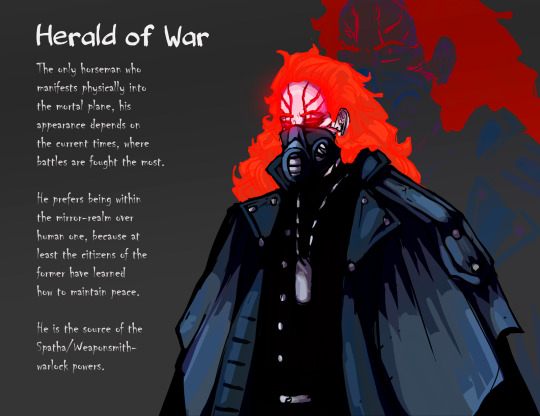


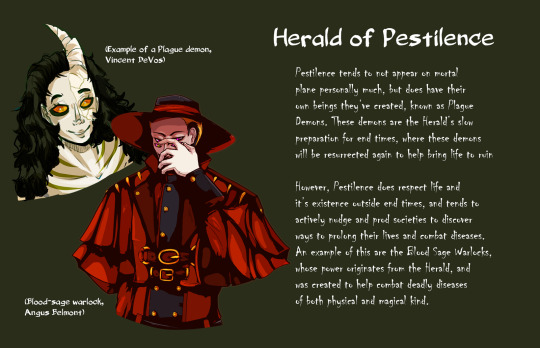
I've been meaning to finish this one for aaaages, but always kept pushing it back. I also wondered if I should draw his full body ref too, but I just can't be bothered rn.
I wanted to go for a slightly different direction from what I typically see portrayed with any Deity relating to War. Nature vise I mean to be exact.
I decided to make this post into more of an info dump on the Heralds beyond just War, given two out of three others are somewhat relevant, even if they don't appear directly at any point. (Famine is not included as they're not relevant in any way)
More info below:
ABOUT WAR/SOLDIER
They are the youngest of the four "siblings" and always manifest last, as life first tends to need to reach sapient state to have actual "wars"
Their appearance changes depending on the times/current cycle. During some lifecycles War might've appeared as a woman for example.
He is currently a white male because of the World Wars being the most recent large-scale battles on earth.
He is generally very mellow and quiet, coming off like someone very tired of just existing, which often tends to confuse those who assume the Herald of War would be more fiery.
The Weaponsmith Warlocks are the only beings directly channeling his power. He initially created this ability in hopes that if someone could "see directly" what he does, they'd start to learn not to cause war so much, but unfortunately that tends to not work...
ABOUT DEATH/END
They are described as a "story collector" by their siblings and Reapers who get to speak with them. Curious to hear the story of each soul a reaper is currently shepherding to the next cycle.
No one really knows what they look like, and the siblings often indicate Death looks like everyone and no-one the same time.
In practice, typically any Grim Reaper discussing with them will just see their own reflection, but with pitch black, void-like eyes. Mortals may sometimes be possessed by a fraction of their essence too, but this is rare.
Death doesn't know where a soul goes once they pass the "veil" as they call it; if there is a heaven or hell or a rebirth. All Death does know that eventually, every single soul - if not destroyed - does make their way to the next cycle of the World itself. (In this story the world basically cycles where it gets destroyed and is reborn over and over again. I think there's even a theory/concept about this in IRL physics lol)
Grim Reapers were all living souls once, choosing to become one either while still alive, or once they are being escorted. Reasons as to why one does so wary greatly.
Death does also permit a fraction of their power to be used for a short period of time without turning into a Grim Reaper, utilizing special stones. these are very risky to use however, since using them for too long transforms you permanently, forcing the individual to leave their past life behind, unable to ever return to their loved ones.
ABOUT PESTILENCE
They are most involved with mortal realm despite not often manifesting physically. They have not one but two "follower" types, both helpful and chaotic ones.
The Chaotic ones are the Plague demons, who, while might have tendencies to be less-than-good people, aren't always necessarily evil either, hence they are described more as "chaotic"
The Helpful ones are the Blood Sage Warlocks, whose powers are typically used to help people with their ailments.
BONUS: Famine
All that is known of them is that they appear as a hermit humanoid that wanders across earth, and wherever they go, the chance of a famine gets higher.
They are very passive and the siblings often indicate they're not really mentally present, less of a person and more of an entity that just exists.
STORY RELEVANCES:
War/Soldier is mostly relevant in NCP/the main story as the "uncle" who visits Marci Raye, and generally may interact with other characters outside their family as well. He is also seen spending time with the local light Deity Spectra, and the Soul Eater King Amaros.
Pestilence & Death: They are relevant to the conflict between Angus Belmont and his ex friends-with-benefits Vincent DeVos. Vincent is obsessed over him, and wants to turn Angus into a Grim Reaper, because that way their souls can reunite at the end once the world is to be purged of life.
Angus is VERY MUCH against this because he has a kid to look after, and a sister to take care of. Also a student. Angus is a good candidate for this, because he already has a connection to the Heralds thanks to his powers, which gave Vincent this idea in the first place. (Already existing connections make these transformations easier)
Vincent's reasoning for wanting Angus to become a Grim Reaper specifically rather than turning him into a Plague demon - which would achieve the same goal - is very shallow and also slightly ignorant; he finds Reapers more attractive than his own kind, and doesn't realize turning Angus into a Reaper would mean he can't be around Vincent either, until the very end (something he'd be too impatient to wait for)
#artists on tumblr#story lore#four horsemen#oc doodles#lumi's chaotic creations#lumi's art scribbles#Night city parlor#the Mage and the Mobster#I'll draw a full body look for War eventually#I just wasn't on the mood for it rn#I wanted to post these already as they'd sat on my computer for months#and I was worried I'd accidentally end up deleting them before I manage to post them#so might as well do it now lol#Ether lore
8 notes
·
View notes
Text
2023 Spotify Wrapped - Friendship Bracelets
Note: I started drinking wine towards the end of this one, might edit later. <3
Appearances: the bracelets appear in three shots of the video.
Relative Position: between to the Devil & Angel on her shoulder and the Burning House in the palm of her hand
Location: They are worn on her right wrist/arm.
Number of bracelets: 8
Number of bracelets with words: 4
Songs spelled out on the bracelets: Cruel Summer, AntiHero, Karma, August
Letter bead colours: pink, purple, blue
Other colours on the bracelets: red, orange, yellow, green, blue, purple
Shaped beads on the bracelets: stars, hearts
Appearances - The bracelets first appear partially obscured in the establishing shot of the burning house, only Cruel Summer is obvious at this point in the video. They're partially visible for a second time in the shot of the 'snow' globe at which point August is legible, they're only fully revealed in the final scene. Their obfuscation is not merely due to cropping her arm moves extending further out of the mountain for the reveal which suggests intentional framing and timing. This links Cruel Summer to the burning house and August to the 'snow' globe.

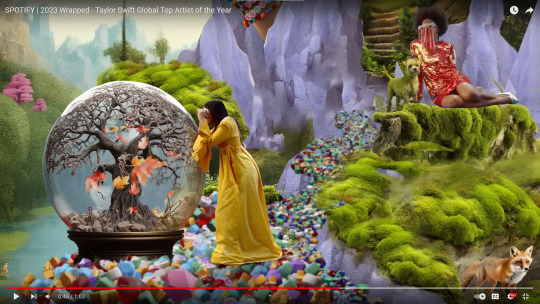

Relative Position and Location - They are positioned between the Devil & Angel, and the Burning House. The bracelets are worn on her right arm while her left arm and hand are hidden within the mountain. TS signs autographs right handed but she plays guitar with her left.
Why is the left hand hidden? It's a common saying that "the right hand doesn't know what the left hand is doing," in business this refers to problems coming up because different departments of a company are oblivious to one another's actions and functions. However, the saying originates from Christian scripture "one should not let the left hand know what the right hand is doing" which means that when you perform charitable acts you shouldn't publicize them: you should do good for the sake of itself not for the sake of appearances. Also in Christian scripture, Jesus is said to sit at the right hand of God, and the implied meaning is one of equality with God and being set above all else. [5]
So perhaps it's that she values her relationships and love above everything else, that she has things to hide, and/or that she is internally conflicted.
To be somebodies right hand man is to be an assistant/helper who you trust completely and rely upon, whereas to be somebodies left-hand man is to be "A man who is being seen on the side by a woman who has another man who is her boyfriend" [4] TS once played a cover of Riptide by Vance Joy on BBC Radio 1 which has the chorus lyric "Lady, running down to the riptide taken away to the dark side I wanna be your left-hand man, I love you…" [8] [9] she smiles an awful lot while she's singing that one. :D
Does the position of each individual tableau within the overall composition point to relationships between the elements?
Notably the adjacent burning house is not the original lover house, it's the newer one with the larger central rooms yet it is engulfed in orange/red flames. In the Eras Tour visuals the original house with its narrow closets burns down at the end of the Lover set in orange flames, while the new house burns during Bad Blood with blue flames. So, why the swap?

In John Milton's fan-fiction of the Bible, Paradise Lost, the "red right hand" is the vengeful hand of God. Red Right Hand is also the title of a song by Nick Cave & The Bad Seeds in the words of the songs co-writer Mick Harvey, it describes "a shadowy, alluring, and manipulative figure, stalking the land and striking a combination of fear and awe everywhere he goes … seemingly part deity, part demon" [6] [7] Given the adjacent Devil/Angel this seems relevant.
If she was having an affair with a woman who was married that would present a lot of internal conflict and tie all these symbols together very neatly. Remember the line in Ivy "He's going to burn this house to the ground" maybe she and the person referenced in Cruel Summer were having an affair and got caught?
Number of bracelets - She's wearing eight friendship bracelets but only four of them include letter beads, so the number of additional bracelets added is a choice. What might eight represent?
TS is a musician and there are eight notes in an octave, it could be something that simple but this is TS. 8 is a rotated infinity symbol and Taylor wore an Infinity bracelet throughout The Long Pond Studio Sessions.

Folklore is her eighth studio album and there were eight versions of Folklore released. The eighth song of her eighth album is August which is also the eighth month of the year. There was an eight minute long standing ovation for Champagne Problems during the Eras tour, it stopped at that time because she stopped it. [1] Y'all I think she really likes the number eight...
In terms of mathematics and etymology eight can be considered the first composite number consisting of the duality of two fours. [2] In numerology eight is associated with; renewal, money, power, the creation and destruction of empires, balance, and of course infinity. [3]
In astrology the eighth sign of the Zodiac is Scorpio and eight is numerically associated with the planet Saturn, in the song Seven, also on Folklore, "Your braid like a pattern, Love you to the moon and to Saturn, Passed down like folk songs, The love lasts so long." August is a song about "a moment in time" but eight is infinity.
Songs - The beads on the bracelets spell out: Cruel Summer, AntiHero, Karma, and August and the letter beads are pink, purple, and blue the bi-pride flag colours. This is reminiscent of the Instagram photo of the bi-pride bracelet back in the Lover promo era. I love this repeated motif because it encourages the belief that "none of it was accidental." The other beads that make up the bracelet include all the colours of the rainbow. It's giving "Gay Pride makes me, me."

The other shape beads on the bracelets are stars and hearts, which admittedly are common bead shapes bought in kits but they also support astrological and romantic interpretations of the bracelets.
Cruel Summer & August are often discussed as sapphic songs, AntiHero and Karma less so.
Although, if AntiHero includes a theme of feeling guilty over closeting herself for so long (instead of being the hero from The Archer) then it might finally explain the whole it's not Purple glitter it's Blue thing which would be nice.
The music video for Karma has scenes of TS as justice balancing the scales, as a demon/the devil removing a mask, of an infinity symbol in the form of an hour glass filled with lavender glitter, of TS and Ice Spice lassoing the Moon & Saturn, and TS as a mountain. Karma is the key that ties the rest together.
Karma also includes TS skipping down the yellow brick road in Oz in ruby slippers but she's not wearing a Dorothy costume - perhaps because she's a Friend of Dorothy? [10]
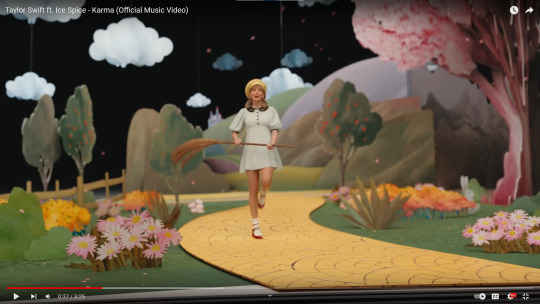
[1] https://english.elpais.com/culture/2023-08-10/scenes-from-taylor-swifts-last-us-concert-eight-minutes-of-applause-and-a-long-awaited-announcement.html
[2] https://en.wikipedia.org/wiki/8
[3] https://numerologist.com/numerology/meaning-mystery-and-magic-of-the-number-8/
[4] https://www.urbandictionary.com/define.php?term=left-hand%20man
[5] https://www.gotquestions.org/right-hand-God.html
[6] https://en.wikipedia.org/wiki/Red_Right_Hand
[7] https://www.azlyrics.com/lyrics/nickcavethebadseeds/redrighthand.html
[8] https://www.azlyrics.com/lyrics/vancejoy/riptide.html
[9] https://youtu.be/2GGRdwfhl-U?si=4Ac8hDPvz2puv83D
[10] https://en.wikipedia.org/wiki/Friend_of_Dorothy
7 notes
·
View notes
Text
i've been thinking abt the gang's ages as of frontiers and especially sonic and how he kind of feels older in frontiers. i think that's been the general course since like colors or something when we got new VAs and writers but imo it kind of culminates in how he acts in frontiers y'know?
like sure part of it is bc sega removed roger from his limiters but also there's this contrast between how sonic acts now and how he acted especially in the adventure era. like adventure/heroes/shth sonic felt much more sincerely carefree and reckless, like a kid freshly turned 15 who didn't really have a scope of what the world could be like and the magnitude of the kind of stuff he was up against. he had had fantastical adventures in the genesis era sure but i think his approach to them bordered on not taking them as the serious occasions they were bc he was so young at the time, and it was just eggman and his robots. then we moved on to ancient deities and eldritch horrors and the tone is permanently altered.
and there's death now, and it personally affects him. maybe he didn't get to know shadow as deeply as rouge and even eggman, but they had an association forced upon them and they wound up fighting against each other and then together as one. maybe it's subtle but i think it does change sonic at the very end of last story, like some of that carefree attitude died that day. maybe his enthusiasm in heroes and shth is compensating for a part of him that he lost on the ARK.
06 has him experience another loss with elise, even if it could be fixed with time travel, but he had grown to really care about her. im not gonna go into the specifics of their relationship bc i have my own interpretations on it that aren't relevant but like that shit has to hurt, even if just a moment. it hammers in that there ARE stakes and they haven't gone anywhere, and just because one person had a miracle survival it doesn't mean sonic is guaranteed a happy ending. it's not that he loses hope or anything, but i'd imagine there is a voice at the back of his head that remembers it and forces him to keep up an appearance harder than before. and it's exactly what he does for the better half of unleashed. because he's a monster now! and maybe that monster thrives with the weight of the past. dark gaia is all about negative energy, and while it's a necessary part of life it can't be an easy burden to bear on the nightly. would sonic have to fight back those feelings harder than before? i doubt he would feel like he deserves to be that way, when he's supposed to keep his friends safe and save the world, because he's the only one who can.
i can't say i remember enough about satbk to fully take it into count here, but by then i think sonic would've been able to rediscover some of the hope that may have eroded. he would be in a better place post-unleashed, having faced parts of him that he had ignored before, and built himself more into the kind of person he'd like to be; free, maybe a little impulsive, but who ultimately follows their own sense of justice. i don't think he would've ever been considered "lawful good" or anything like that, but maybe he was somewhere close to that when he was younger, subscribing to the idea of a cosmic and righteous good and inherent evil. but that had to change when he learned the world wasn't that simple.
im brushing over colors/gens/lost world/forces here a bit, the first three didn't feel of substance to me and if anything forces was a showcase of keeping up the appearances for the others. but frontiers feels like this culmination of everything so far, and we get to observe sonic in isolation for the first time in a while. most other serious events in the past have had him work together with his friends, but they're only sort of present now, and it makes parts of the curtain drop especially as the game goes on. sonic hides and downplays the corruption because he has to be the carefree and courageous guy he's always been, even if it's been a few years and he's growing up and changing as he does. and he's experienced despair time and time again, and it's hurt, so he forces himself to cling to hope with everything he has now, even when his whole body is overcome by corruption and eating him like a ravenous organic beast. he's grown to care for the people around him much more than he maybe used to, to cherish life as long as it lasts, but it's hard to be the same bright-eyed hero everyone knows you as when you've seen what death looks like. he wants it to go away but it'll always remain, and colors the curtains he puts up so his brother and sister and rival don't have to worry about him.
i keep thinking about the opening lines of sonic adventure and ryan drummond's voice saying goofy 90s flavored lines, and i keep thinking about roger craig smith delivering sonic's lines in frontiers in a tone subtly deeper and different from his previous performances
#soda offers you a can#lore drabbles#listen. maybe frontiers isn't the pinnacle of sonic gaming sure i wouldn't know bc i only like bad games#but i think this game is growing very important to me in multiple ways#sonic#long post#dear god i did not expect this to be such a lengthy drabble
16 notes
·
View notes
Text

Tirupati’s Rich History: Discovering Ancient Temples and Legends
Tirupati, a name synonymous with spirituality, is not just a popular pilgrimage site but a place steeped in centuries of history, culture, and mythology. While the Tirumala Venkateswara Temple draws millions of visitors annually, the city and its surroundings are home to numerous ancient temples and captivating legends that narrate the rich spiritual heritage of this sacred land.
In this blog, we will explore some of Tirupati’s most historic temples and the timeless legends that make them special.
1. Tirumala Venkateswara Temple: The Jewel of Tirupati
History
The Tirumala Venkateswara Temple, perched atop the Tirumala Hills, is the heart of Tirupati’s spiritual legacy. The temple is dedicated to Lord Venkateswara, a form of Lord Vishnu, who is believed to have descended to Earth to protect his devotees. The temple’s history dates back over a thousand years, with its origins often attributed to the Chola Dynasty and further developed during the Vijayanagara Empire.
Legend
The legend of Lord Venkateswara is deeply rooted in mythology. According to one tale, the deity is said to have descended to Earth during the Dvapara Yuga to forgive the sins of mankind. It is also believed that Lord Venkateswara took a vow to remain on Earth until all of humanity’s sufferings were alleviated, making his presence ever-relevant in the hearts of devotees.
2. Sri Kalahasti Temple: The Ancient Shiva Shrine
History
Located just 36 kilometers from Tirupati, the Sri Kalahasti Temple is one of the most revered temples dedicated to Lord Shiva. It is famous for its association with the ancient tradition of Vayu Linga worship, representing the air element. The temple has a rich history and was first built by the Pallava Kings in the 5th century, with later contributions from various dynasties like the Cholas and Vijayanagara Empire.
Legend
The temple's history is intertwined with a popular legend involving a spider, snake, and elephant. It is said that these three creatures worshiped Lord Shiva at the site in their own ways, leading to the manifestation of the Vayu Linga, a powerful and divine form of Lord Shiva. The temple’s name, Kalahasti, is derived from the combination of Kala (spider), Hasti (elephant), and Taksaka (snake), who are believed to have shown the way to salvation through devotion.
3. Sri Padmavathi Ammavari Temple: The Goddess of Tiruchanoor
History
Located in the Tiruchanoor area of Tirupati, the Sri Padmavathi Ammavari Temple is dedicated to Goddess Padmavathi, the consort of Lord Venkateswara. The temple holds great significance as it is believed that Lord Venkateswara married Goddess Padmavathi here, after a divine courtship that spanned many mythological events.
The temple’s origins date back to the Pallava and Chola Dynasties, and it continues to be one of the most visited temples in the region.
Legend
According to legend, Goddess Padmavathi appeared in a lotus flower to bless the devotee Atri Maharishi. Another myth links the goddess to the story of Lord Venkateswara’s search for a suitable bride, where he found Padmavathi and took her as his divine consort. Devotees believe that worshipping her ensures marital bliss and prosperity.
4. Talakona Waterfalls: The Hidden Temple of Lord Sri Sai Baba
History
Situated amidst the lush greenery of the Sri Venkateswara Wildlife Sanctuary, the Talakona Waterfalls is not just a scenic spot but also home to an ancient temple dedicated to Lord Sai Baba. The area is famous for its natural beauty and spiritual significance, offering a peaceful escape for pilgrims who wish to connect with nature.
Legend
It is said that Lord Sai Baba once visited Talakona and meditated under a huge banyan tree near the waterfalls. Devotees believe that this divine presence made the area spiritually potent, and it is now an important pilgrimage site for those seeking Sai Baba’s blessings.
5. Sri Kapileswara Temple: The Serene Shiva Temple
History
Located on the foothills of Tirumala, the Sri Kapileswara Temple is one of the oldest temples in Tirupati, dedicated to Lord Shiva. The temple is also significant for its connection to Kapila Maharishi, who is believed to have meditated here, bringing divine energy to the location.
Legend
According to the legend, Kapila Maharishi once performed severe penance in the region to seek the blessings of Lord Shiva. In honor of the sage, Lord Shiva appeared and granted him a Shivalinga. The temple stands as a testament to this divine meeting and continues to attract devotees seeking peace and spiritual solace.
Conclusion
Tirupati’s rich history and ancient temples offer a unique glimpse into India’s spiritual and cultural past. From the towering grandeur of the Tirumala Venkateswara Temple to the serene beauty of the Sri Kapileswara Temple, every shrine in this sacred city has a story to tell, steeped in mythological significance and divine presence.
Whether you're a history enthusiast, a spiritual seeker, or a traveler exploring India’s heritage, Tirupati’s temples and legends provide a profound experience that will stay with you forever. If you're planning a trip, consider booking a guided tour with trusted services like Tirupati Balaji Package, which offer tailored travel experiences to explore the temples and their fascinating stories.
0 notes
Text
Murugan in Gold: Exploring the Radiant Splendor of Tanjore Art
Introduction
Tanjore paintings are synonymous with grandeur, vibrancy, and divine allure. Among the myriad deities depicted in this traditional art form, Lord Murugan stands out as a symbol of youth, power, and wisdom. Adorned in gold and surrounded by the lavish details characteristic of Tanjore art, Murugan's depiction is not just a visual treat but also a spiritual experience. In this blog, we delve into the radiant splendor of Murugan in Tanjore art, exploring the techniques, symbolism, and enduring appeal of these magnificent paintings.
The Golden Glow of Tanjore Paintings
Tanjore paintings are celebrated for their distinctive use of gold foil, which adds a shimmering brilliance to the artworks. This technique, combined with vivid colors and intricate detailing, creates a sense of divine radiance that is unmatched by other art forms. In paintings of Murugan, this golden glow plays a crucial role in highlighting the deity's divine attributes and elevating his presence within the artwork.
Techniques and Craftsmanship
Gold Foil Application: The hallmark of Tanjore paintings is the use of 22-carat gold foil, meticulously applied to areas of the painting to enhance its grandeur. For Murugan, the gold is often used on his crown, armor, jewelry, and the ornate thrones or backgrounds, making the deity appear regal and otherworldly. This use of gold not only catches the eye but also symbolizes purity, prosperity, and divine energy.
Gesso Work: To achieve the three-dimensional effect that Tanjore paintings are known for, artists use a technique called gesso work. A paste made from a mixture of chalk powder and gum arabic is applied to specific areas to create raised surfaces. This is typically seen in the depiction of jewelry, garlands, and other embellishments on Murugan, giving the painting texture and depth.
Intricate Detailing: The attention to detail in Tanjore paintings is remarkable. Artists use fine brushes to paint delicate features, ornate patterns, and intricate designs on Murugan’s attire and surroundings. The precision and care taken in these details contribute to the overall splendor and allure of the artwork.
Symbolism and Iconography of Murugan
Murugan, also known as Skanda, Kartikeya, or Subrahmanya, is depicted with various attributes that carry deep symbolic meanings:
The Vel (Spear): The Vel is Murugan's primary weapon and a symbol of knowledge, valor, and the destruction of evil. It represents the power to cut through ignorance and darkness, guiding devotees towards enlightenment.
The Peacock: Murugan’s mount, the peacock, is a symbol of beauty, grace, and victory. In Tanjore paintings, the peacock is often shown with its vibrant feathers spread wide, enhancing the painting's overall visual appeal.
Murugan’s Six Faces: In some Tanjore depictions, Murugan is portrayed with six faces (Shanmukha), representing his multifaceted nature and his ability to see in all directions, signifying his omniscience.
The Cultural and Spiritual Essence
Murugan holds a special place in the hearts of devotees, especially in Tamil Nadu and other parts of South India. Tanjore paintings of Murugan are not just decorative pieces; they are embodiments of faith, devotion, and cultural pride. They are often placed in homes and temples as a source of divine blessings and protection. The radiant gold, the intricate craftsmanship, and the powerful symbolism of Murugan make these paintings a cherished part of South Indian cultural heritage.
Modern Relevance and Adaptations
In contemporary times, the art of Tanjore painting has seen a revival, with artists exploring new themes and styles while staying true to traditional techniques. Murugan Tanjore paintings continue to be popular, not just in India but around the world. They are sought after by collectors, art enthusiasts, and devotees alike for their beauty, craftsmanship, and spiritual significance.
The appeal of Murugan Tanjore paintings transcends time and geography, making them a timeless piece of art that bridges the past and the present. Whether displayed in a modern home or a traditional temple, these paintings bring a sense of peace, prosperity, and divine connection.
Conclusion
Murugan Tanjore paintings are a glorious celebration of divine art. The radiant gold, intricate details, and symbolic elements combine to create artworks that are not only visually stunning but also spiritually uplifting. As we continue to explore and appreciate this art form, the splendor of Murugan in Tanjore paintings will undoubtedly continue to shine, inspiring devotion and admiration for generations to come.
1 note
·
View note
Text
Feet of clay: Ba‘la-be’a and her siblings
Last week Two weeks ago Like a month ago (I’ve been writing on this for a while), researchers and students of Ancient West Asia met in Helsinki for the yearly Rencontre Assyriologique Internationale. There were a lot of interesting lectures by philologists, archaeologists, historians, what have you, but one that really touched me was concerned with a set of footprints impressed in clay and was given by Samantha Rainford. I will try here to retell the story of Ba‘la-be’a and her siblings, but it has been a few weeks and my notes are, well, succinct.
Over 3000 years ago, in the city of Emar by the Euphrates River, a woman named Ku’e attempts to sell off her daughter Ba‘la-be’a, stating in a sale contract:
My husband went away; [my/our] children were all babies [and I did not have anyone] who could feed them. Therefore I have sold my daughter Ba‘la-be’a to be a daughter of ‘Anat-’ummī, wife of Šegal, son of Ikki, and thus I could feed the other small children of mine during year of the famine.
(Translation by Carlo Zaccagnini, Feet of Clay at Emar and Elsewhere, 1994; square brackets indicate reconstructed text.)
However, ‘Anat-’ummī appears to not have paid the agreed upon price and thus, the sale is cancelled. Still in need of money and, despite her husband’s return, unable to care for her children, Ku’e thus finds another buyer, the diviner Ba‘l-mālik. This time, though, as a second contract records, it is not only Ba‘la-be’a she gives up, but also her sons Ba‘l-bēlī and ’Išma‘-Dagan, as well as her baby daughter Ba‘la-’ummī, whom she promises to hand over once she has been weaned. In the context of this sale, Ku’e and her husband Zadamma impressed the feet of their three older children into clay. From the size of one of the footprints, Carlo Zaccagnini tentatively assumes that Ba‘la-be’a, the eldest of the children, was only two years old when she was sold away.
(The following is a photo of Ba‘l-bēlī’s footprint as published in Jean-Claude Margueron’s Les Mésopotamiens, Tome 2, 1991.)

But what was the deal with the feet of clay? Artifacts like these are rare. All the more interesting are thus the following sentences from a series of tablets used for scribal education, Ana ittišu (published by Benno Landsberger, Die Serie ana ittišu, 1937):
He who has no father nor mother He who knows not his father or mother He was found in a well, brought in from the street He took him from the mouth of a dog Before witnesses he took his foot They sealed the measure of his feet with the seal of the witnesses.
(Ana ittišu 3 iii 28–44; my translation does not differ significantly from Landsberger’s.)
One might interpret these sentences as an orphan’s adoption that is documented legally by taking a measure of the child’s foot. A similar passage may be available to us in one of the earliest Mesopotamian law collections, the Code of Lipit-Ištar, which precedes the much more famous Code of Hammurāpi by almost two centuries, although the relevant part is broken off: “If a man rescues a child from a well, he shall […] feet […]” (translation by Martha Roth, Law Collections from Mesopotamia and Asia Minor, 1995).
Rainford supposes that the man who bought the children, Ba‘l-mālik, might have been aware of these texts. As a diviner, after all, he was a member of the Mesopotamian intelligentsia. By having the toddlers’ feet impressed in clay, he thus may have been imitating a tradition regarding the adoption of orphaned children.
We don’t know anything further about the life of Ba‘la-be’a and her baby sister. Their brothers, however, Yoram Cohen suggests, may have been trained as scribes by Ba‘l-mālik, for we find their, albeit common names, as signatures under two lexical lists, that is, ancient dictionaries: “Hand of Ba‘l-bēlī, novice diviner, servant of (the scribal deities) Nabû and Nisaba” (translation by Cohen, Feet of Clay at Emar: A Happy End?, 2005). A happy end indeed? In a world that forces parents to sell their children for fear of starvation, maybe.
0 notes